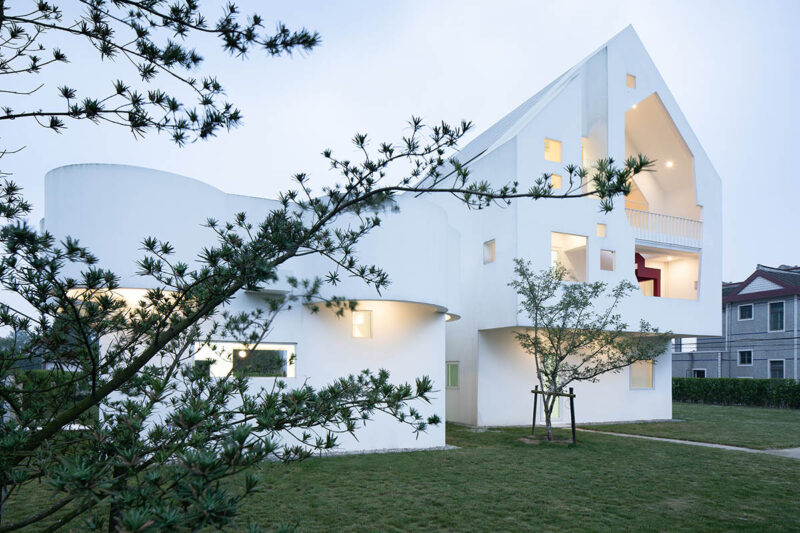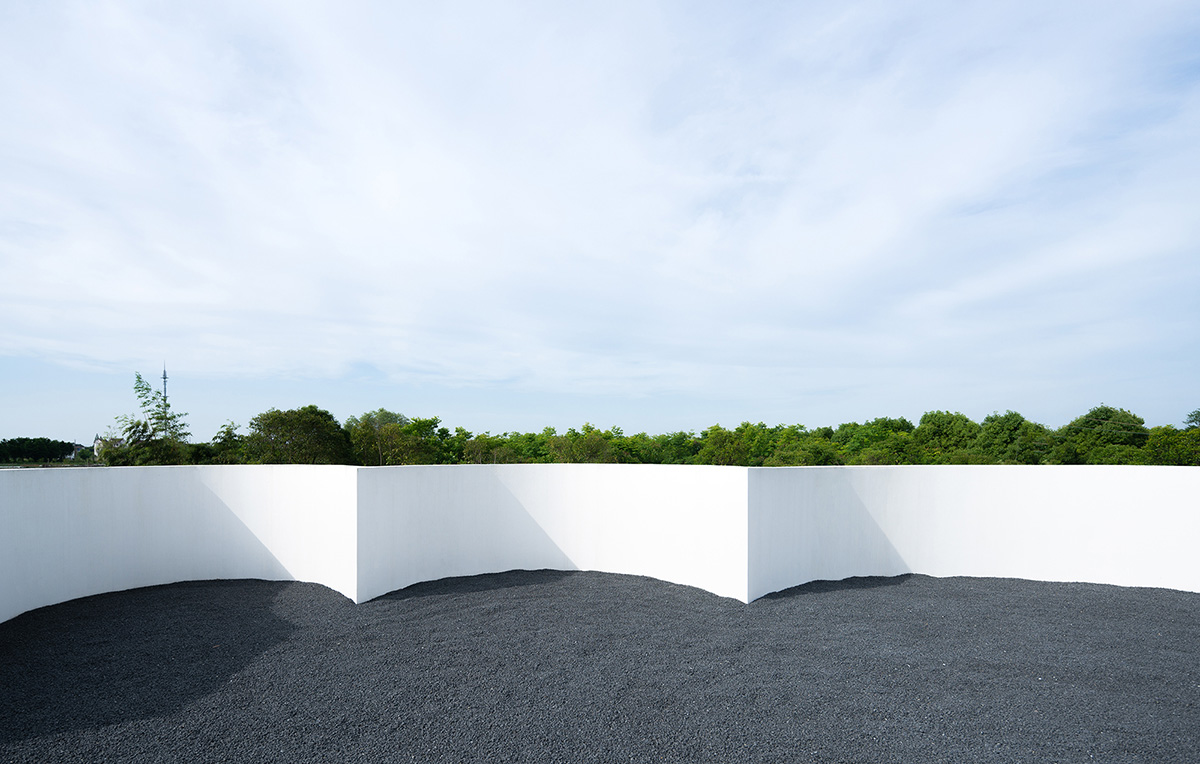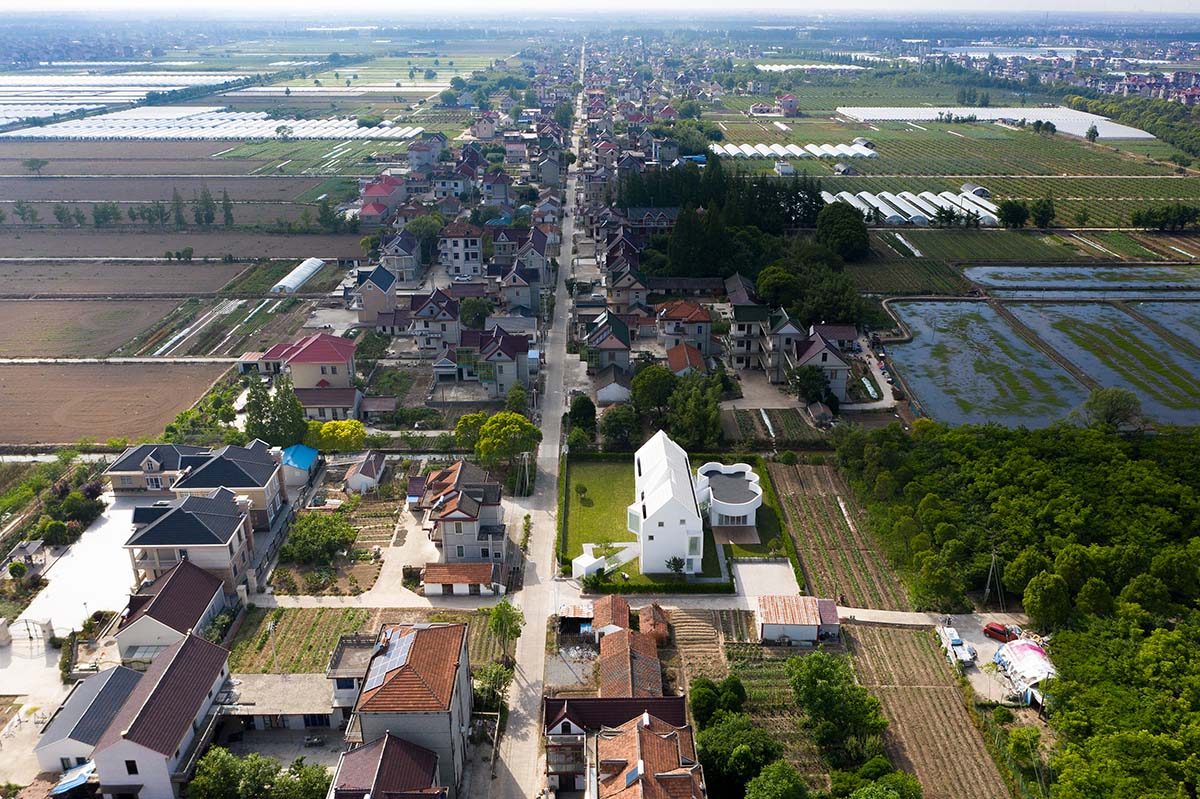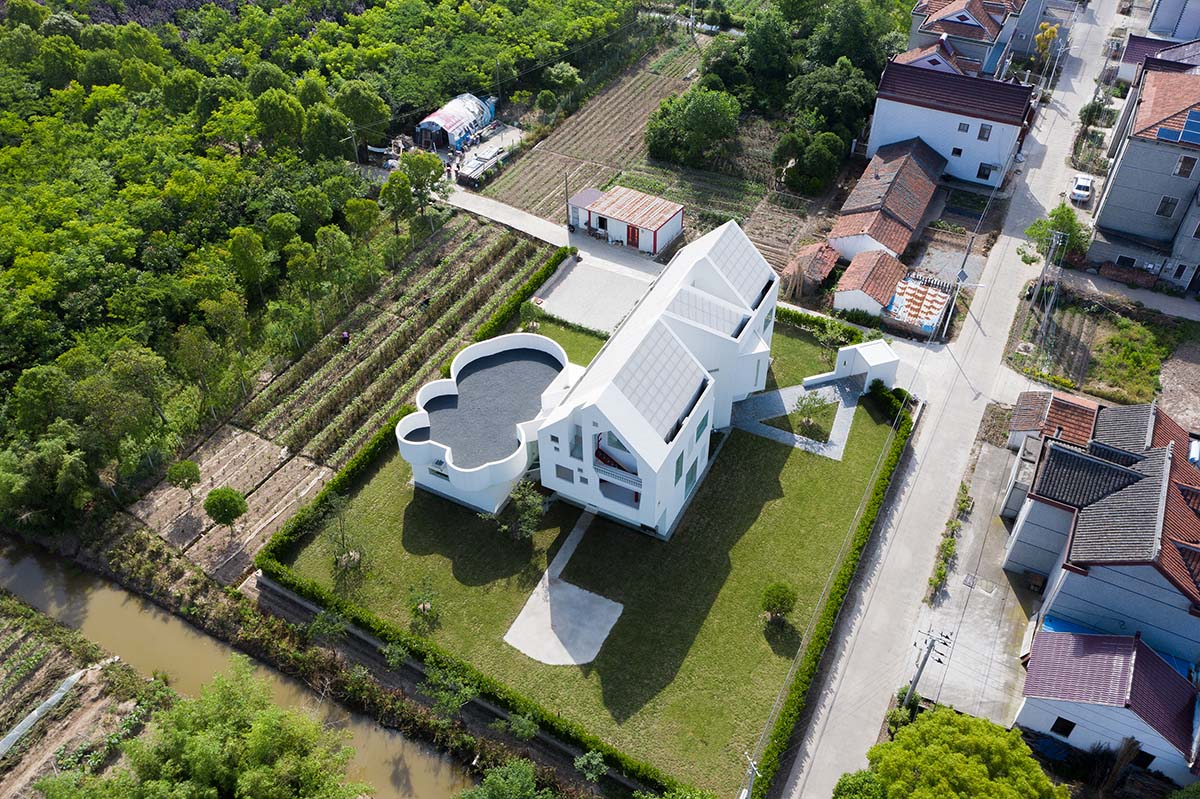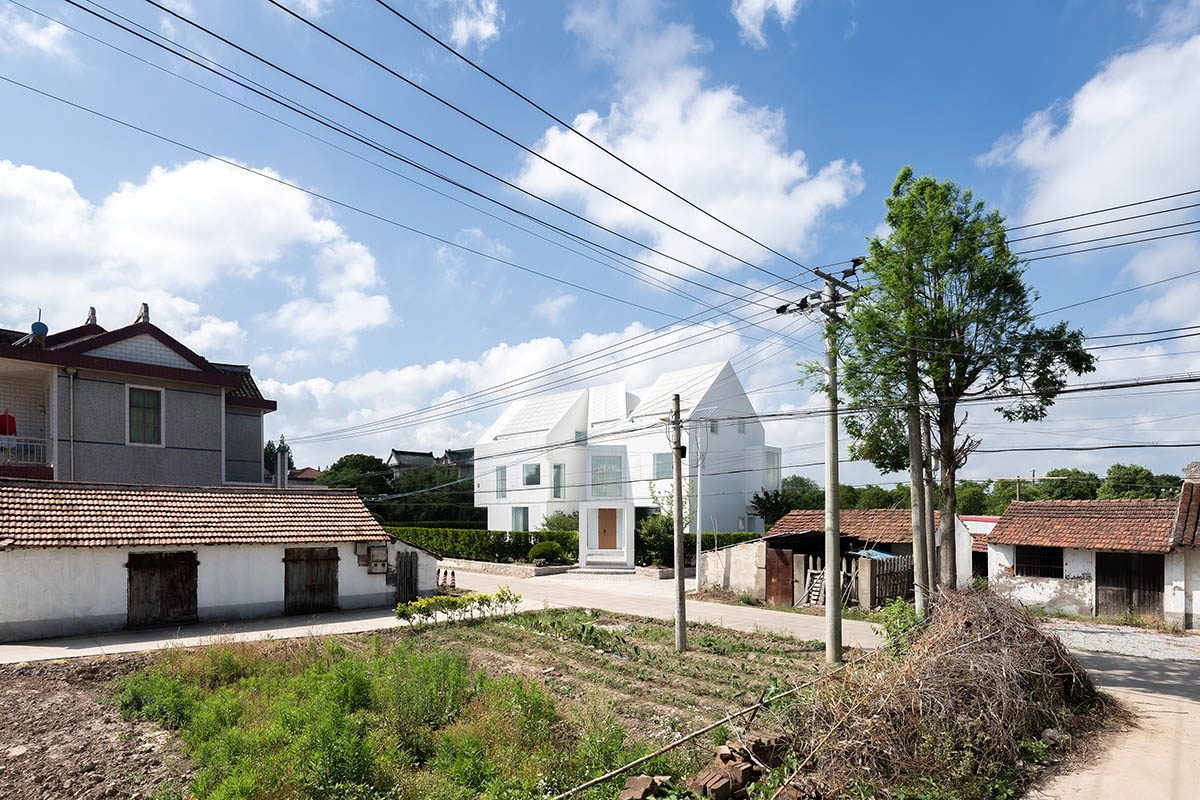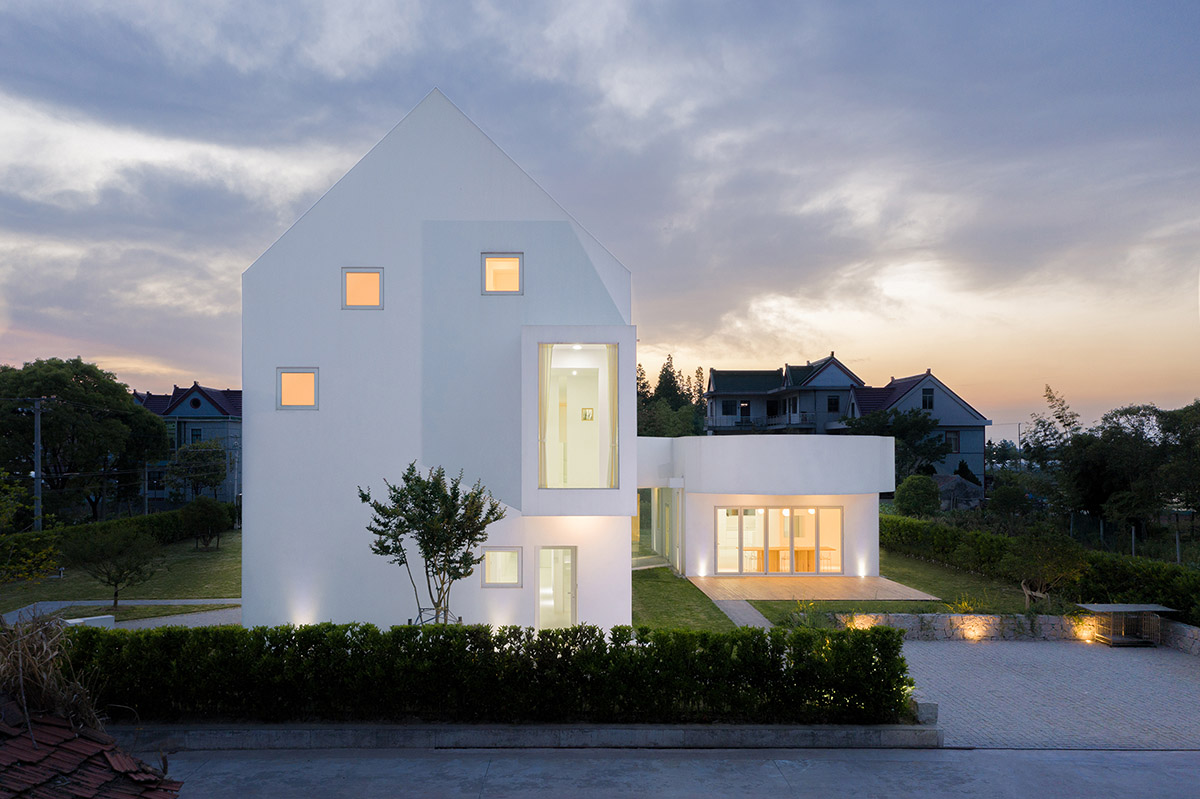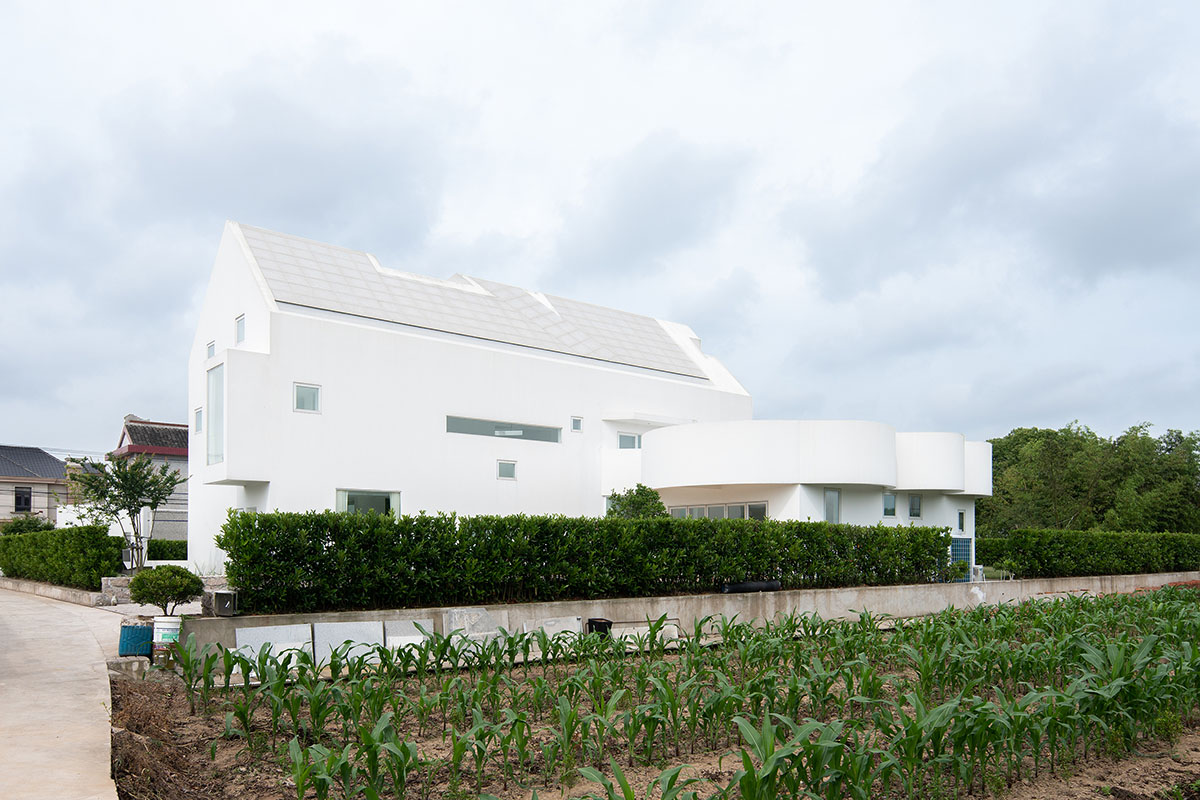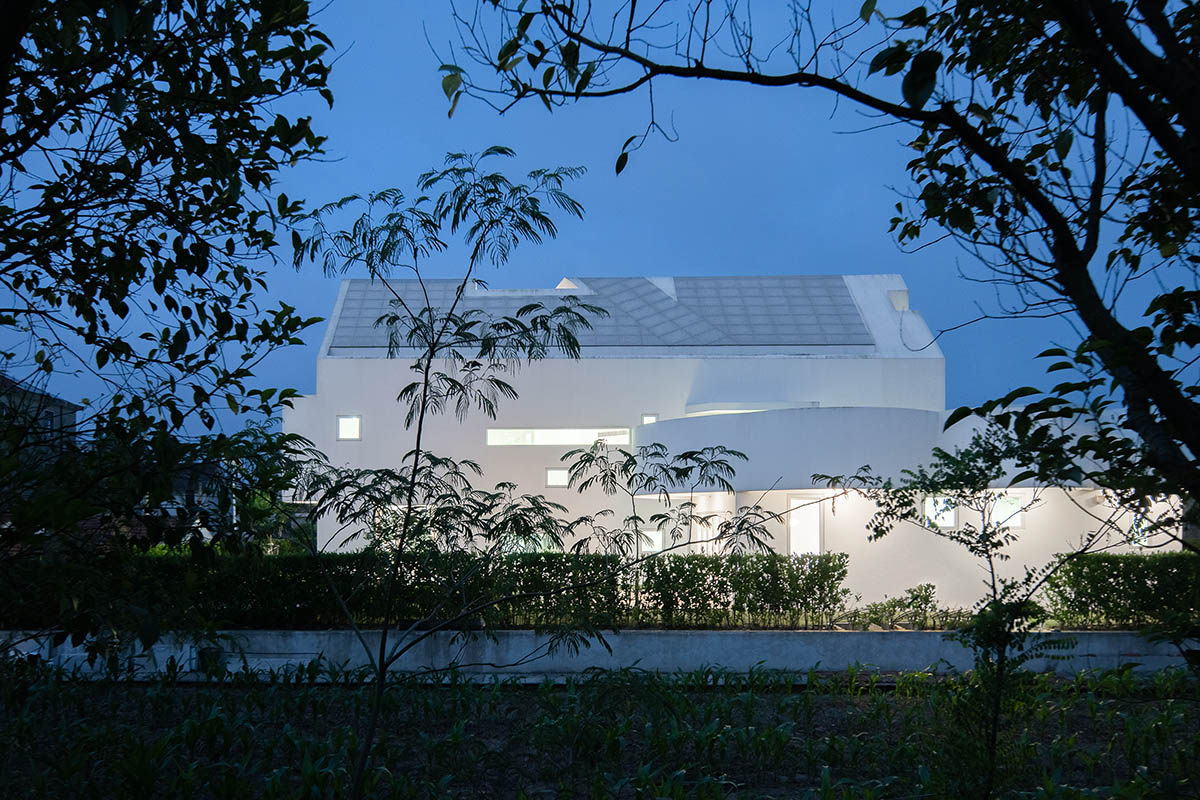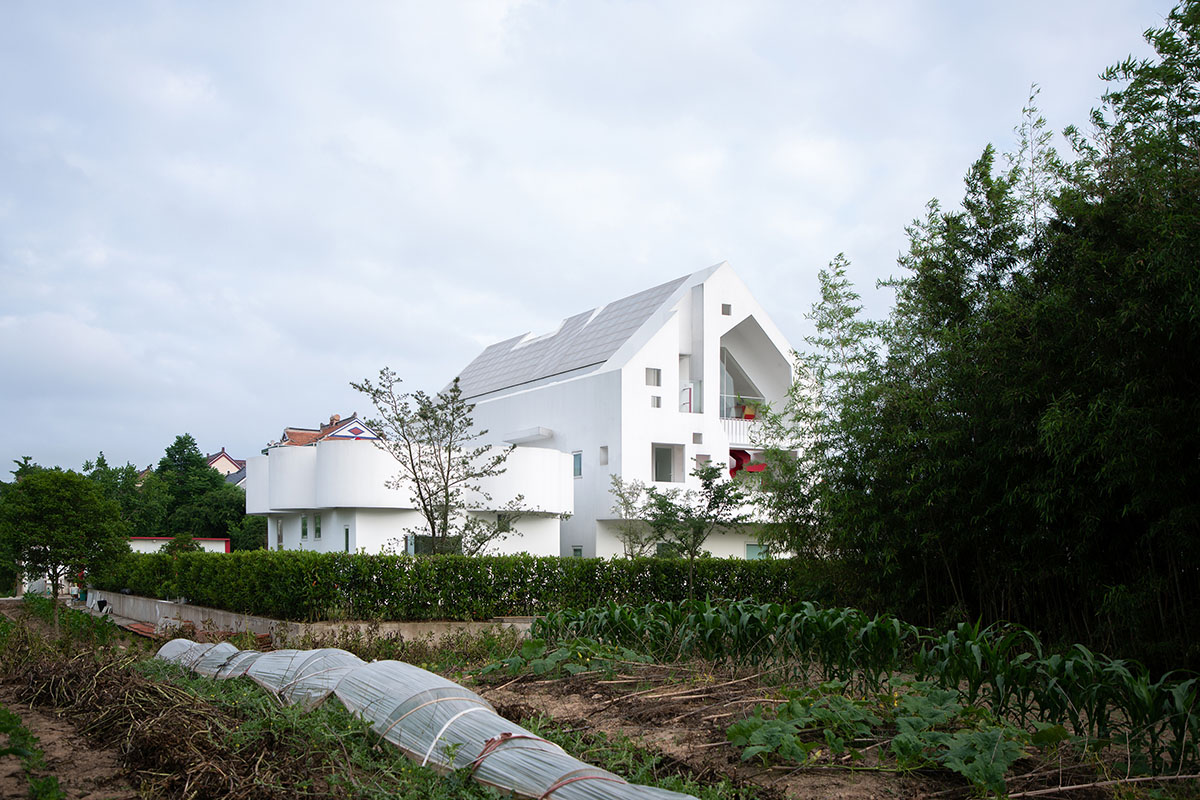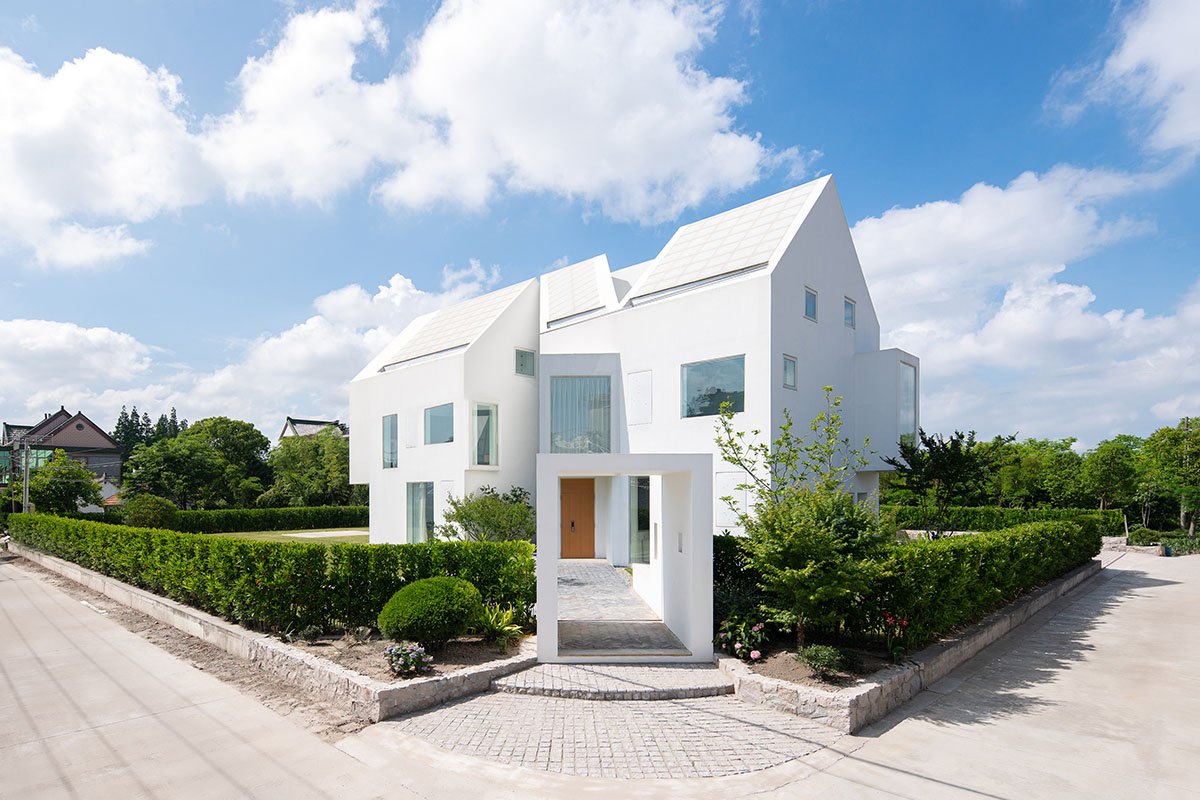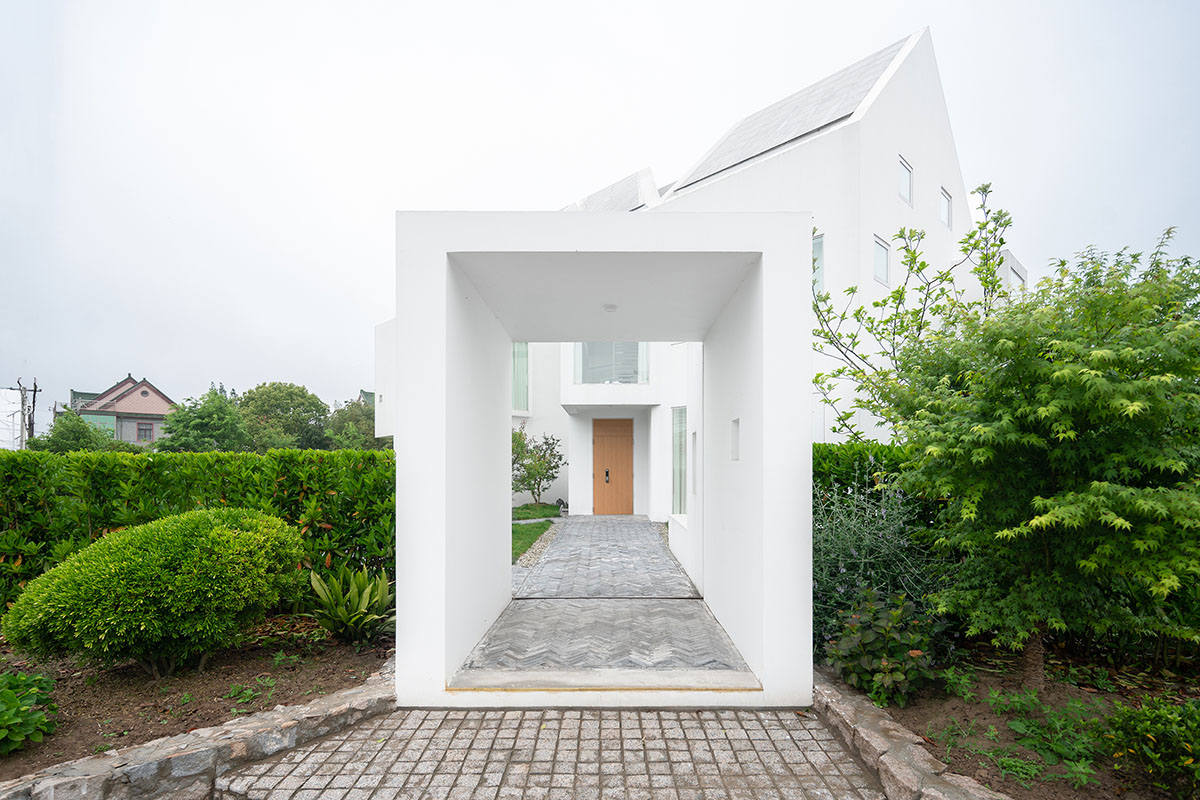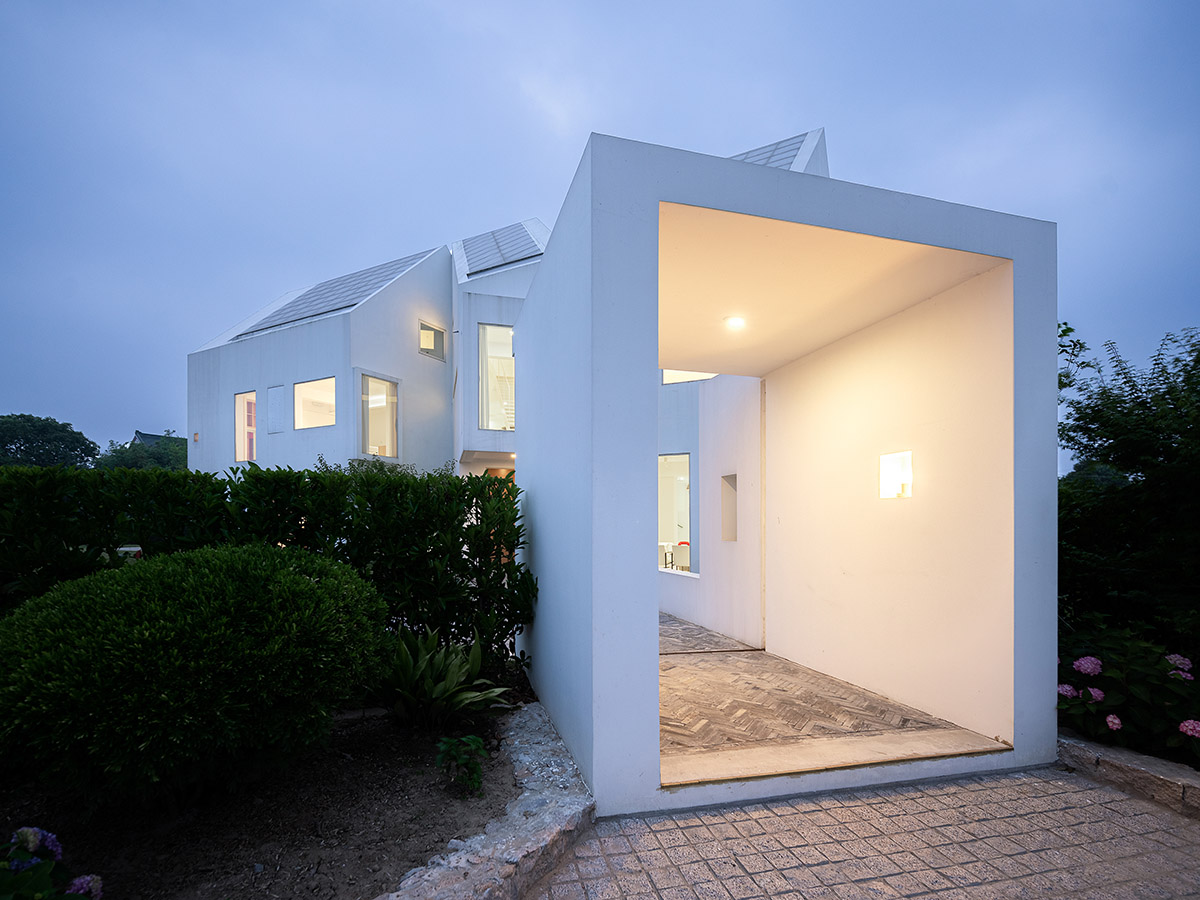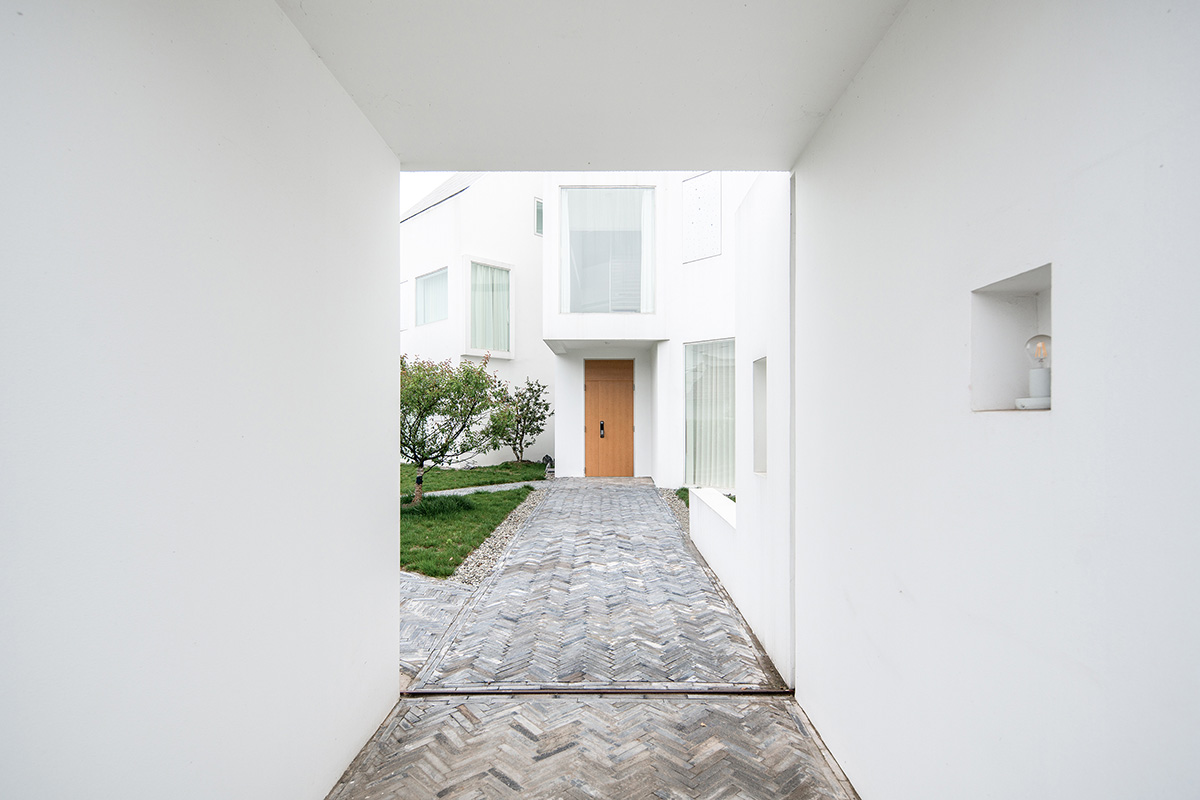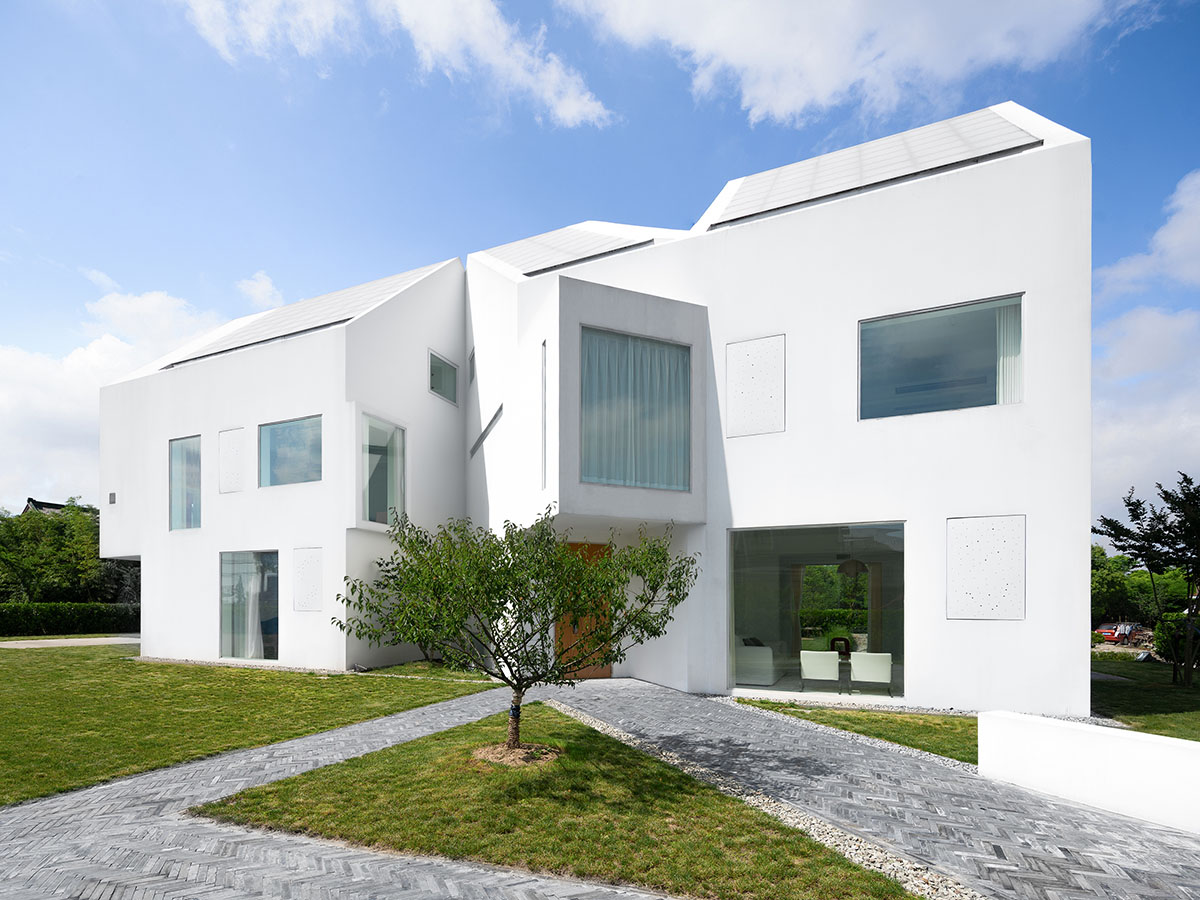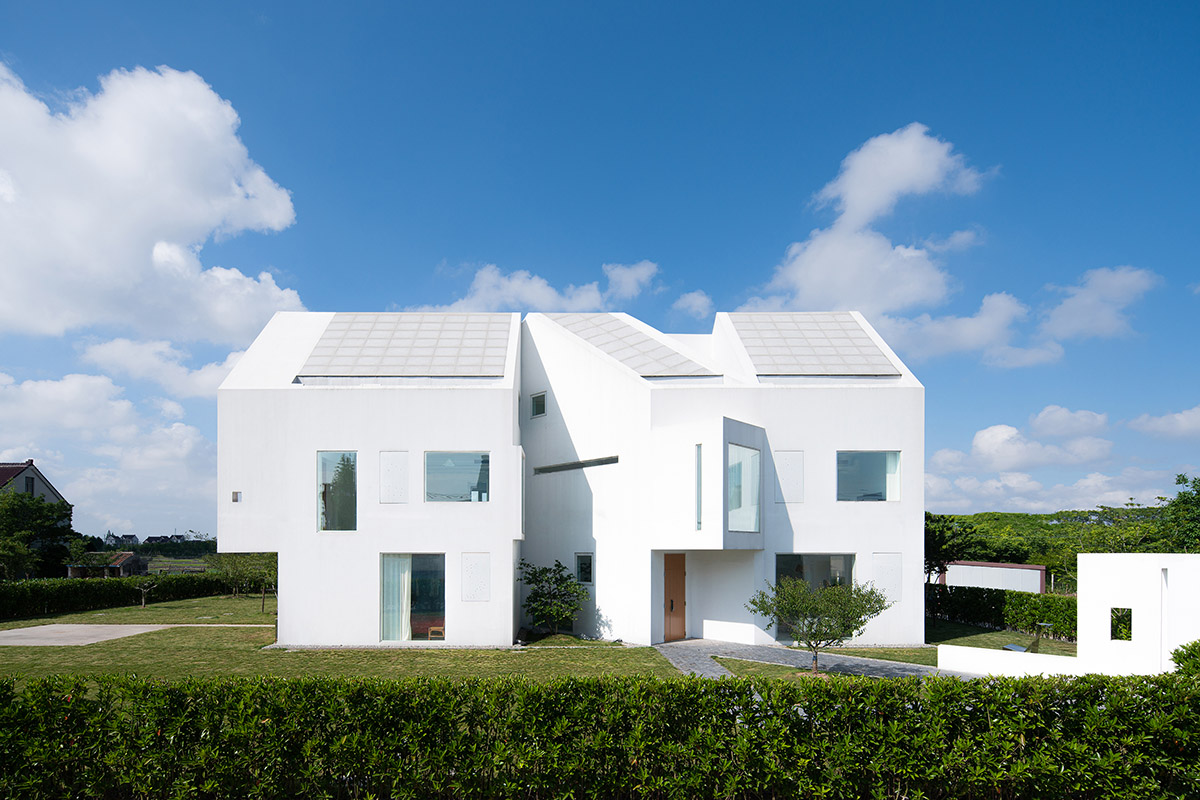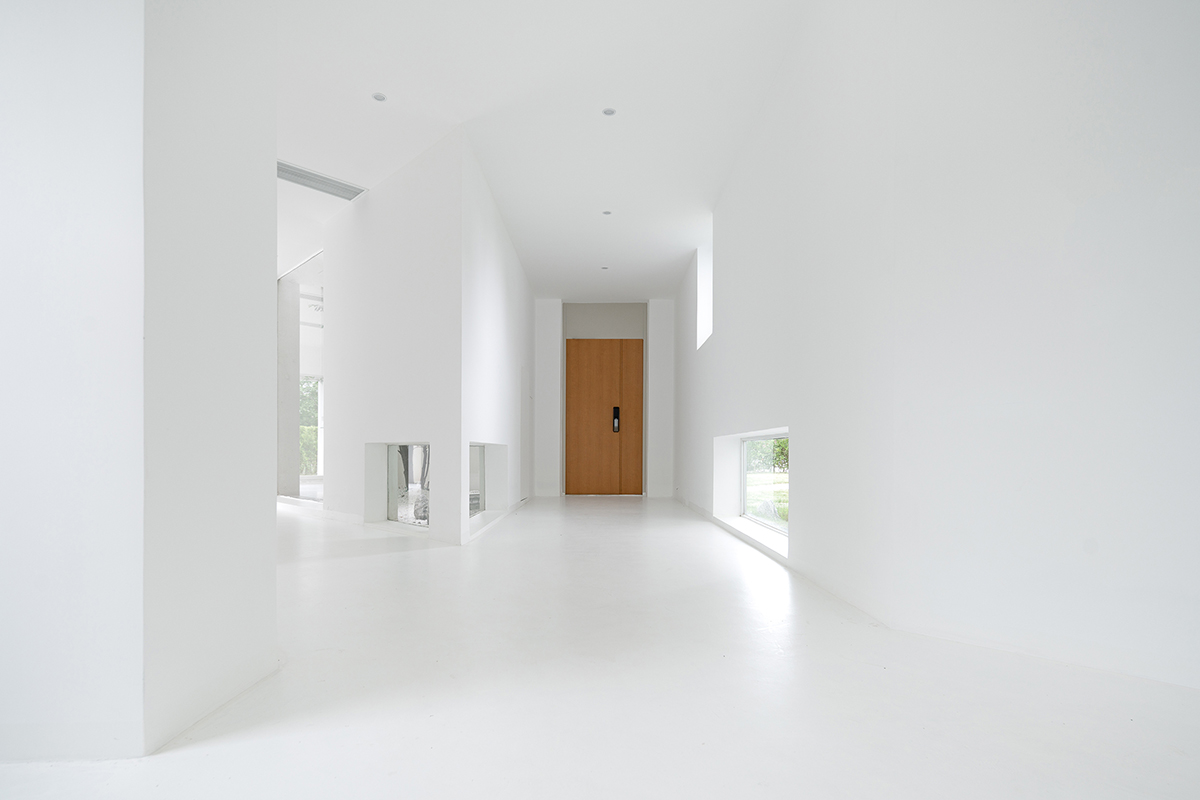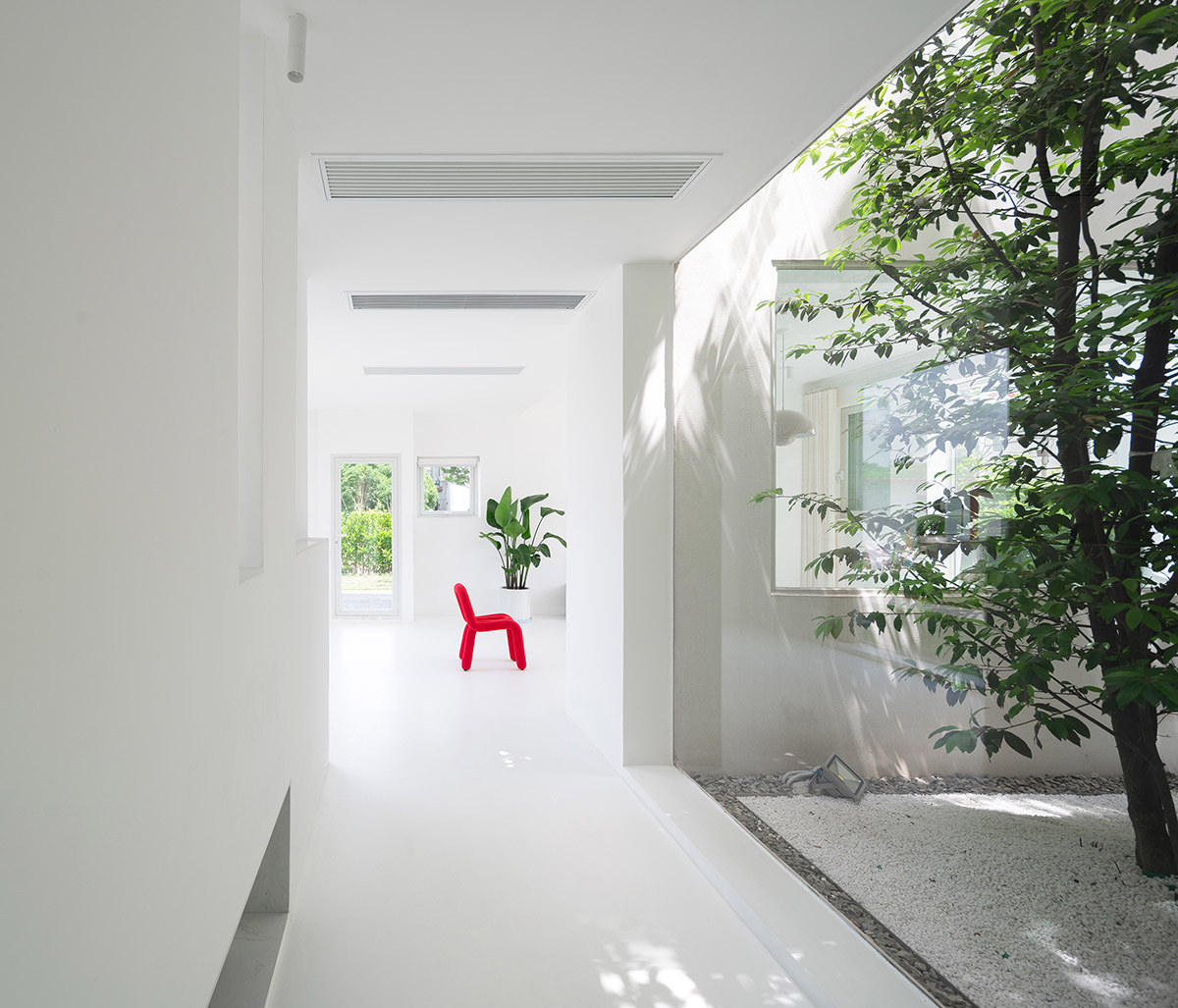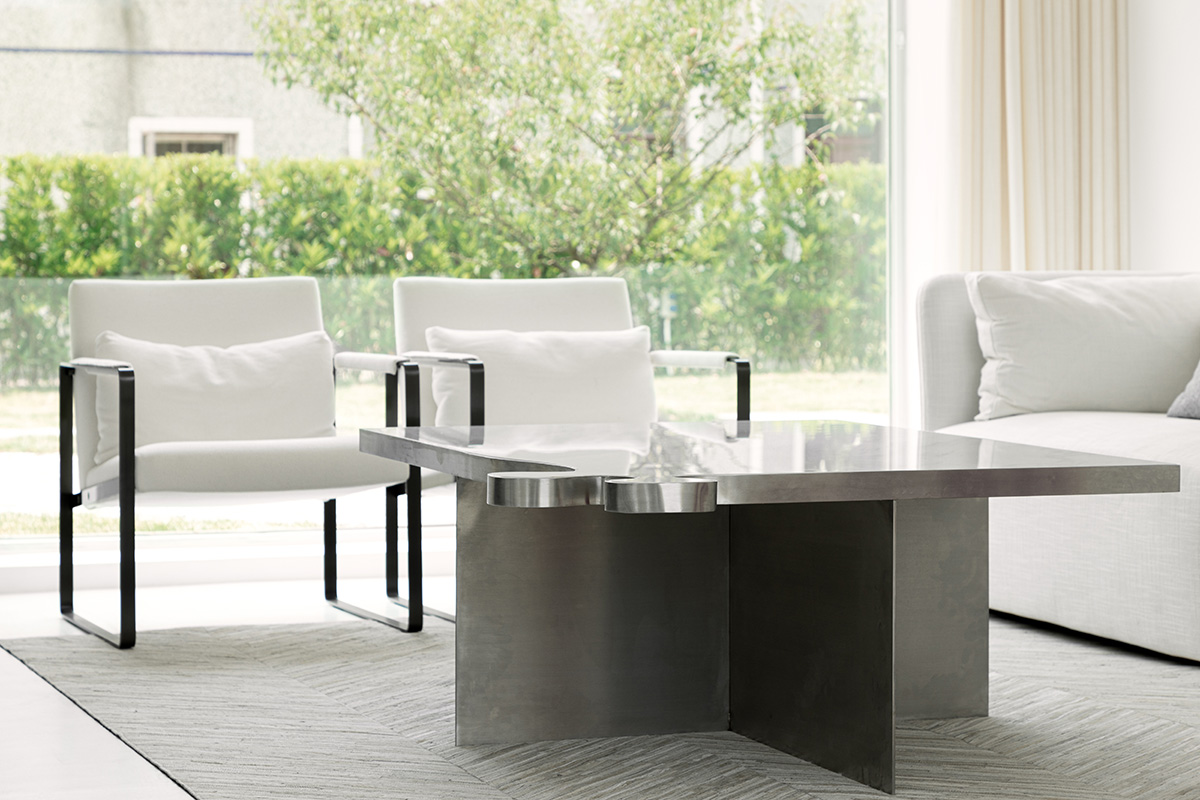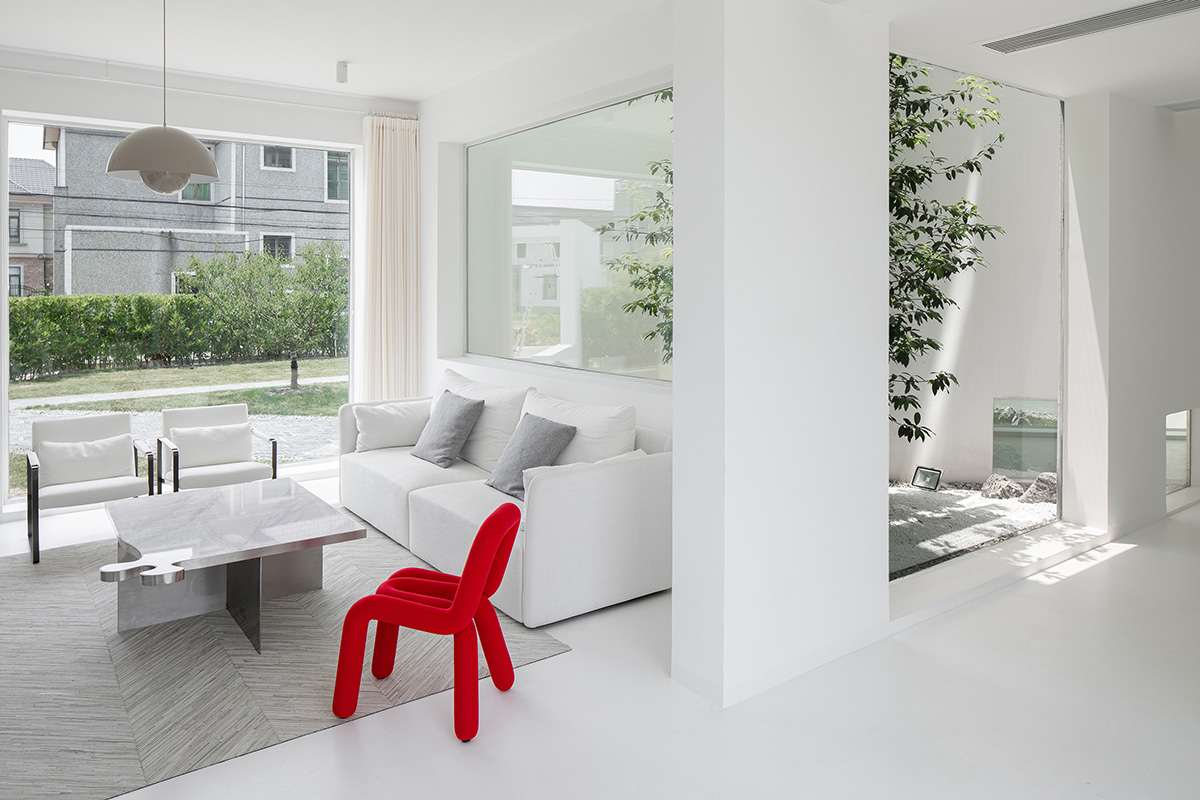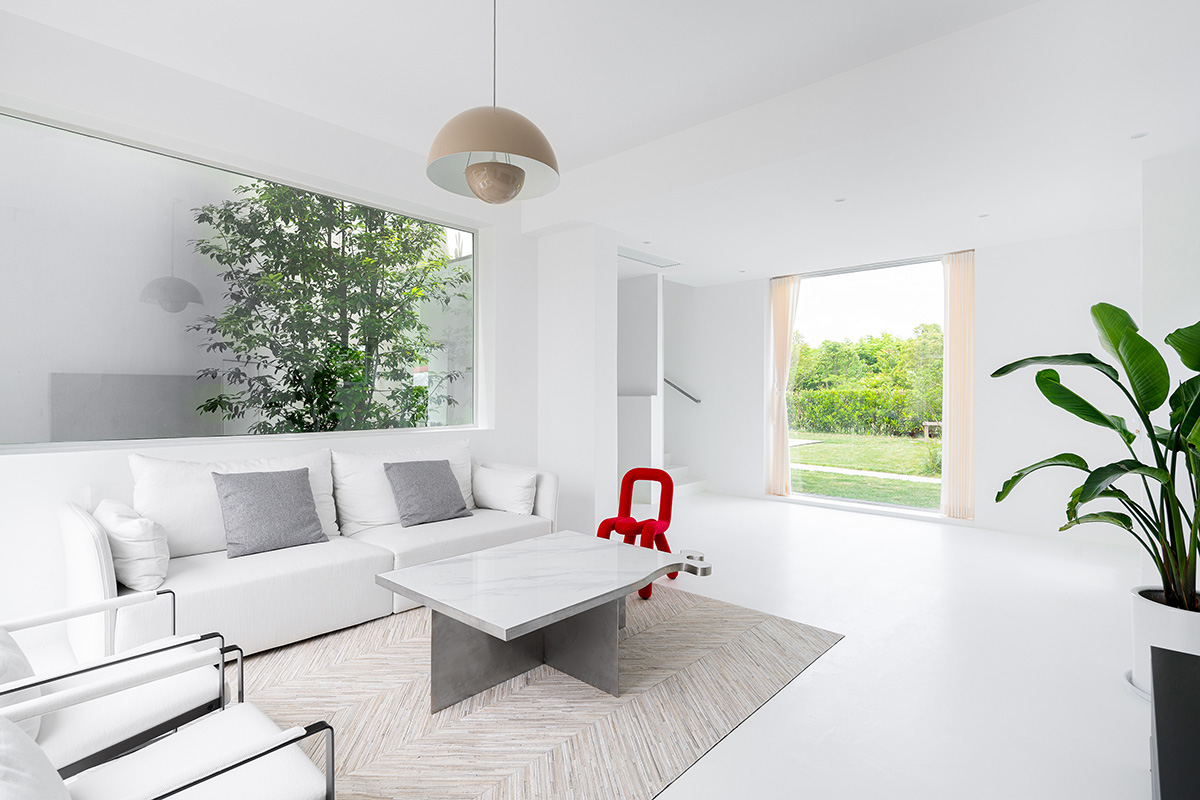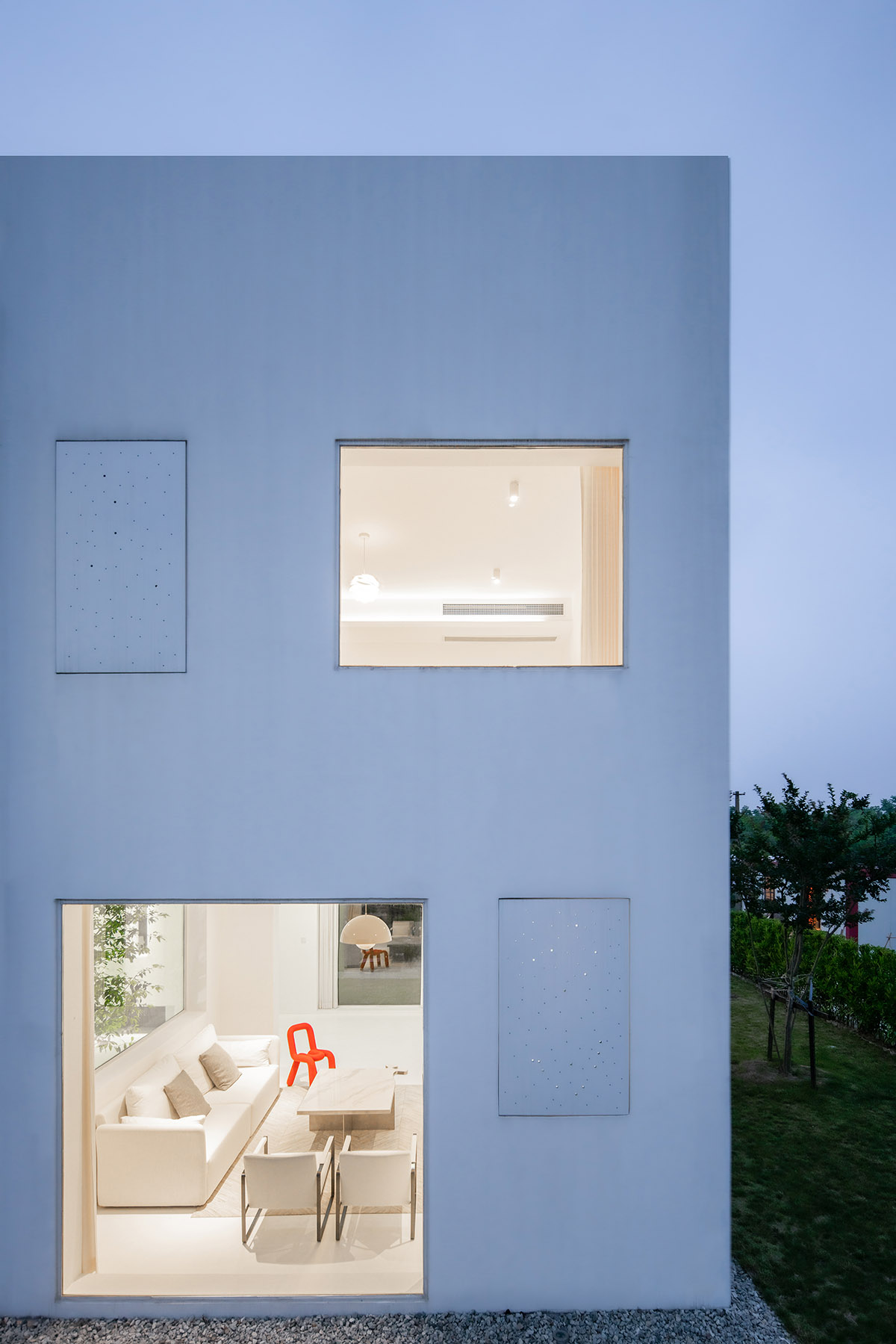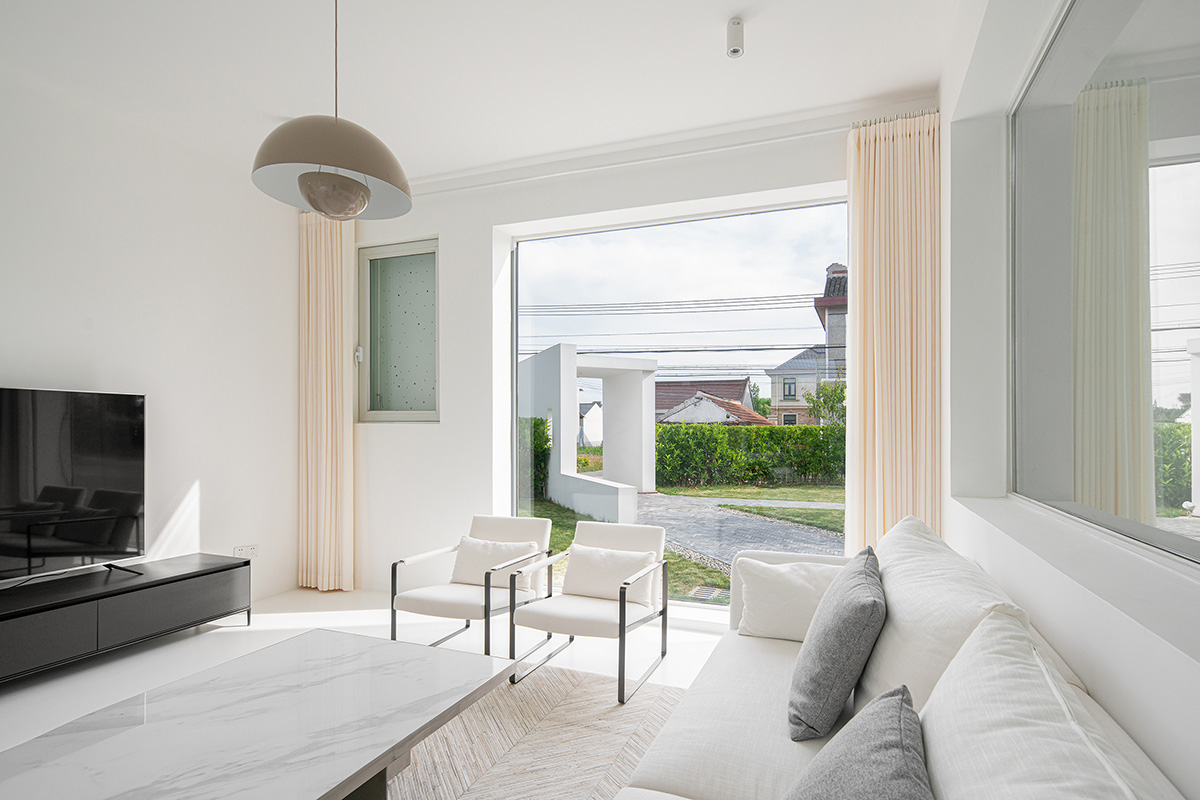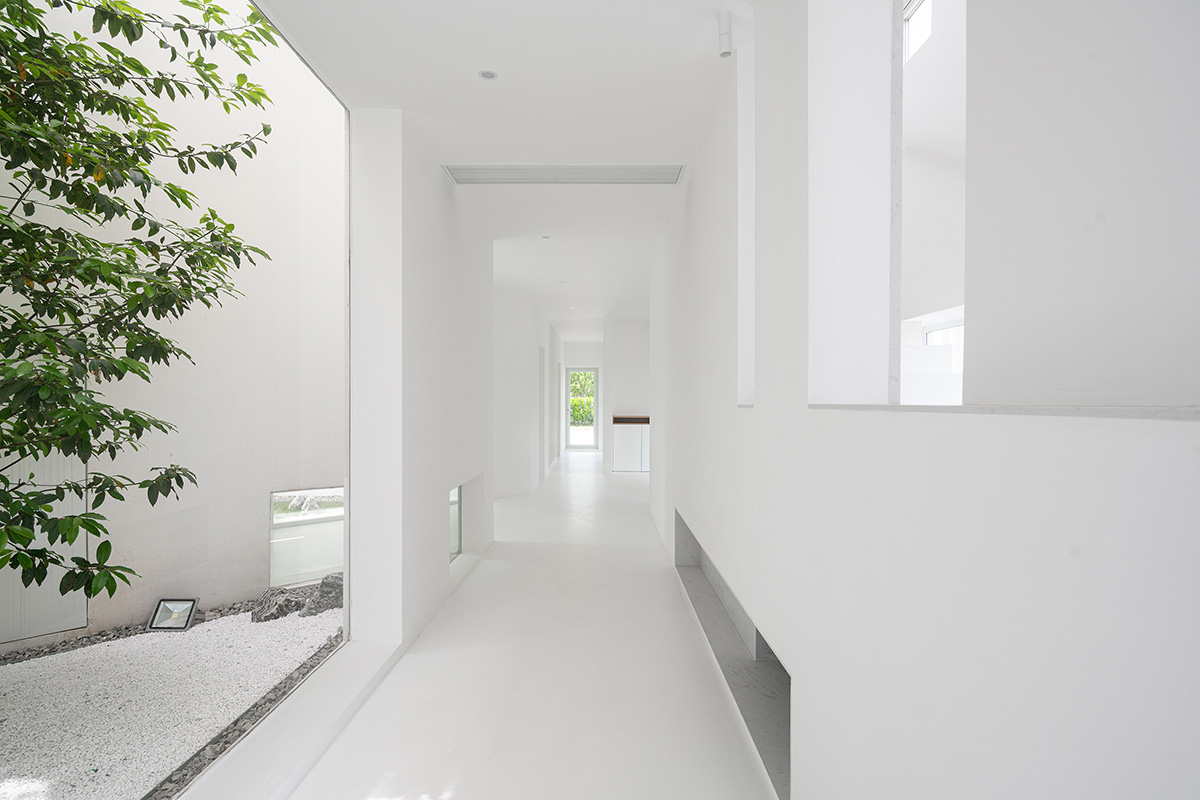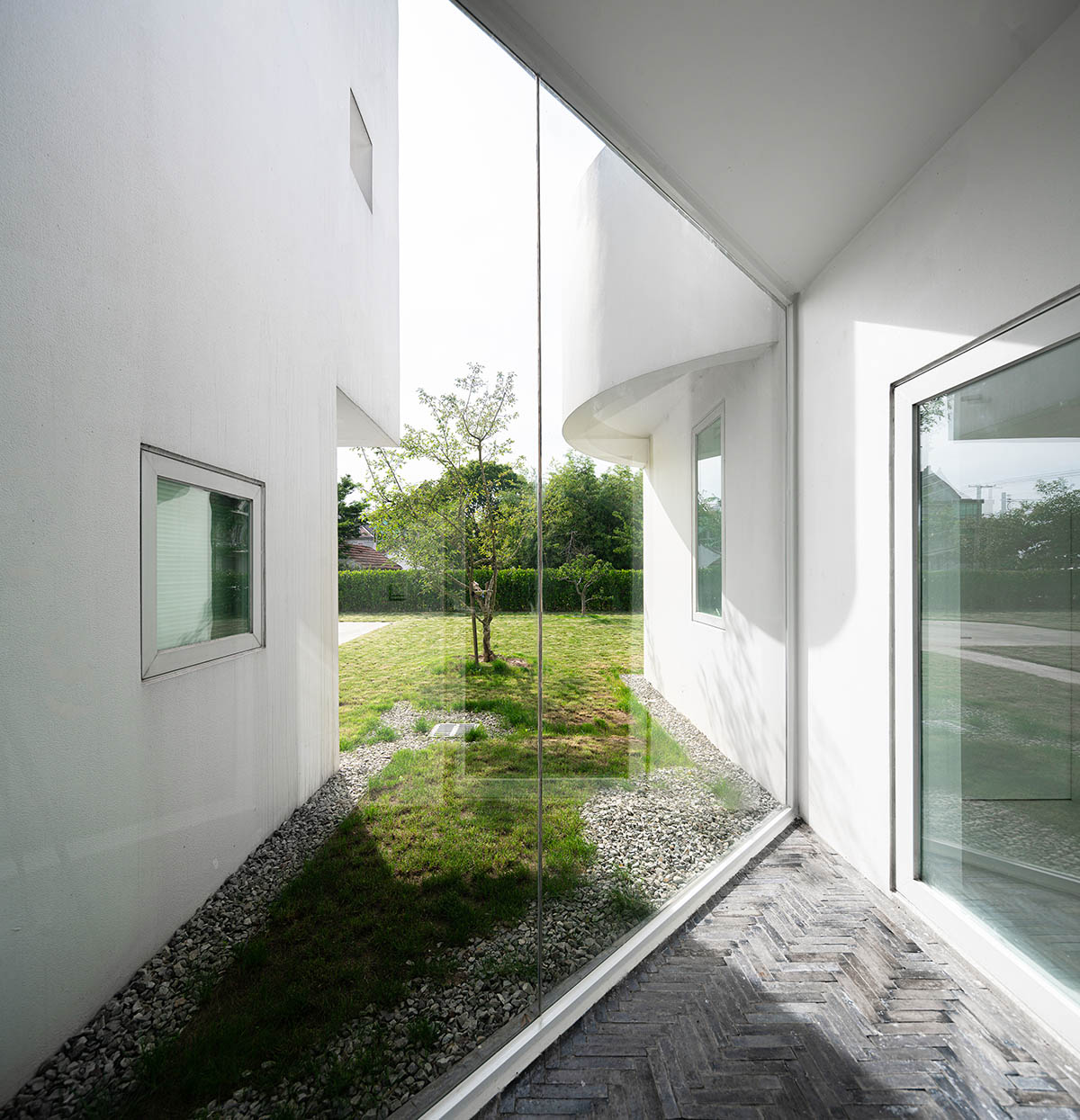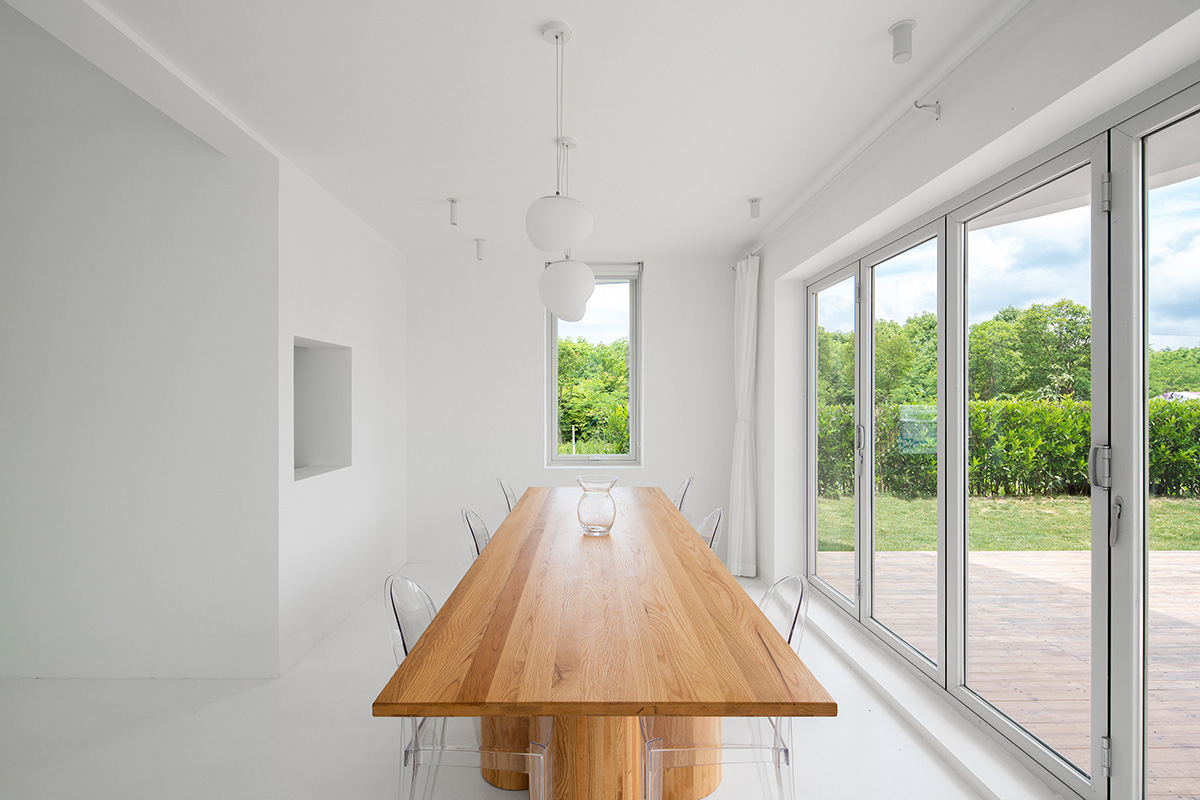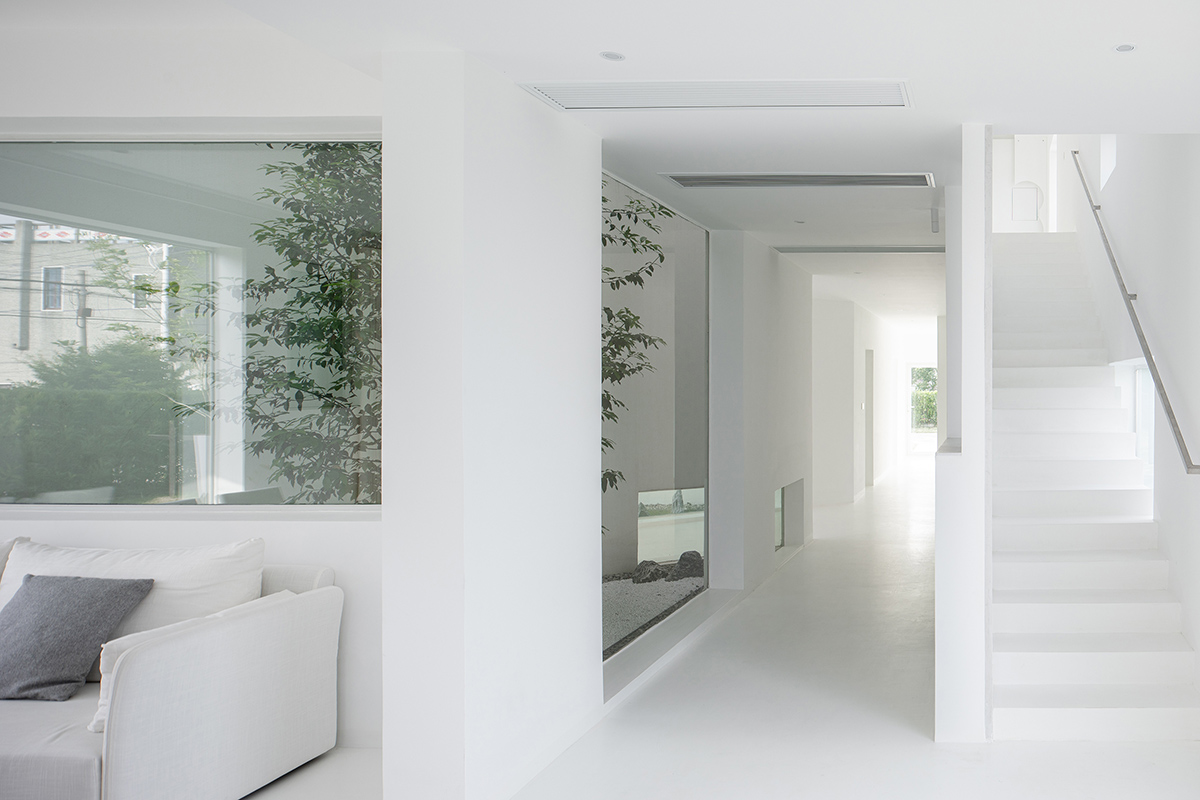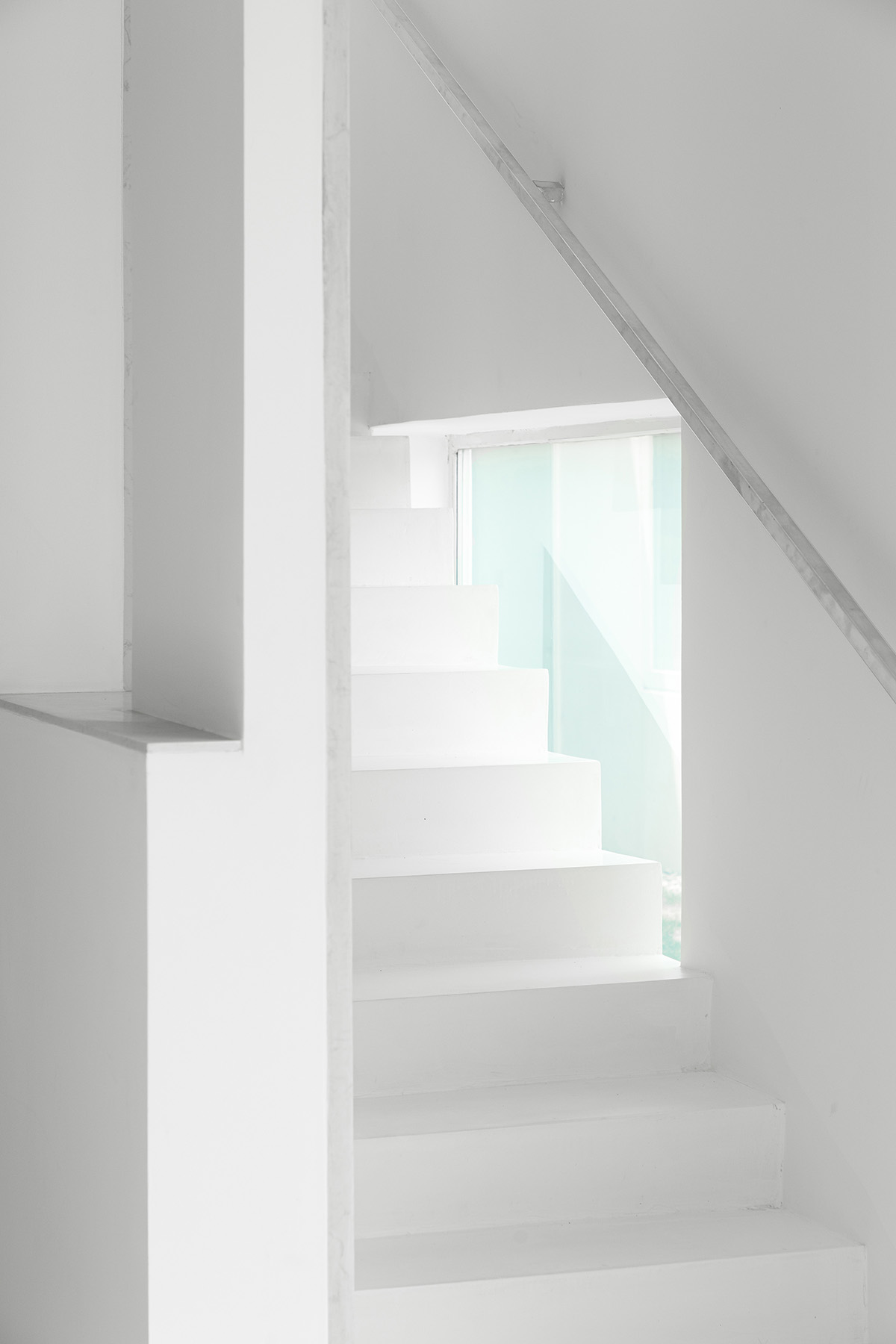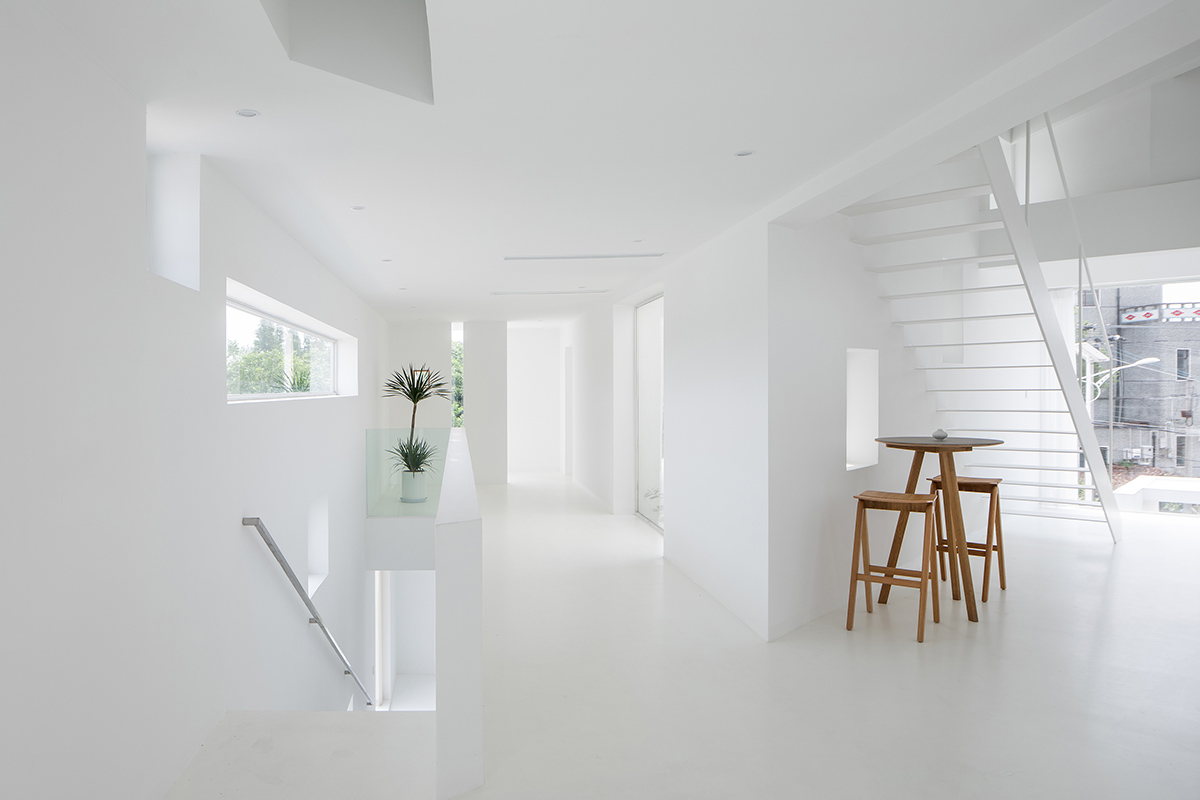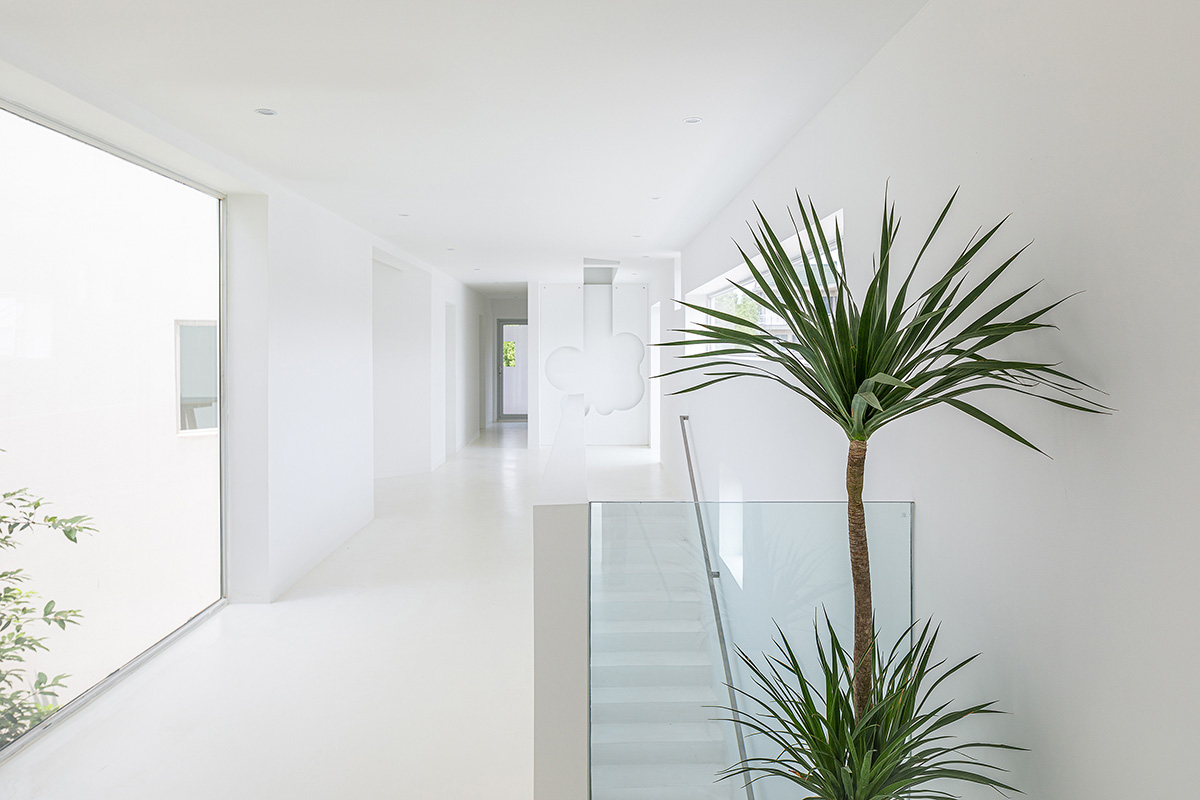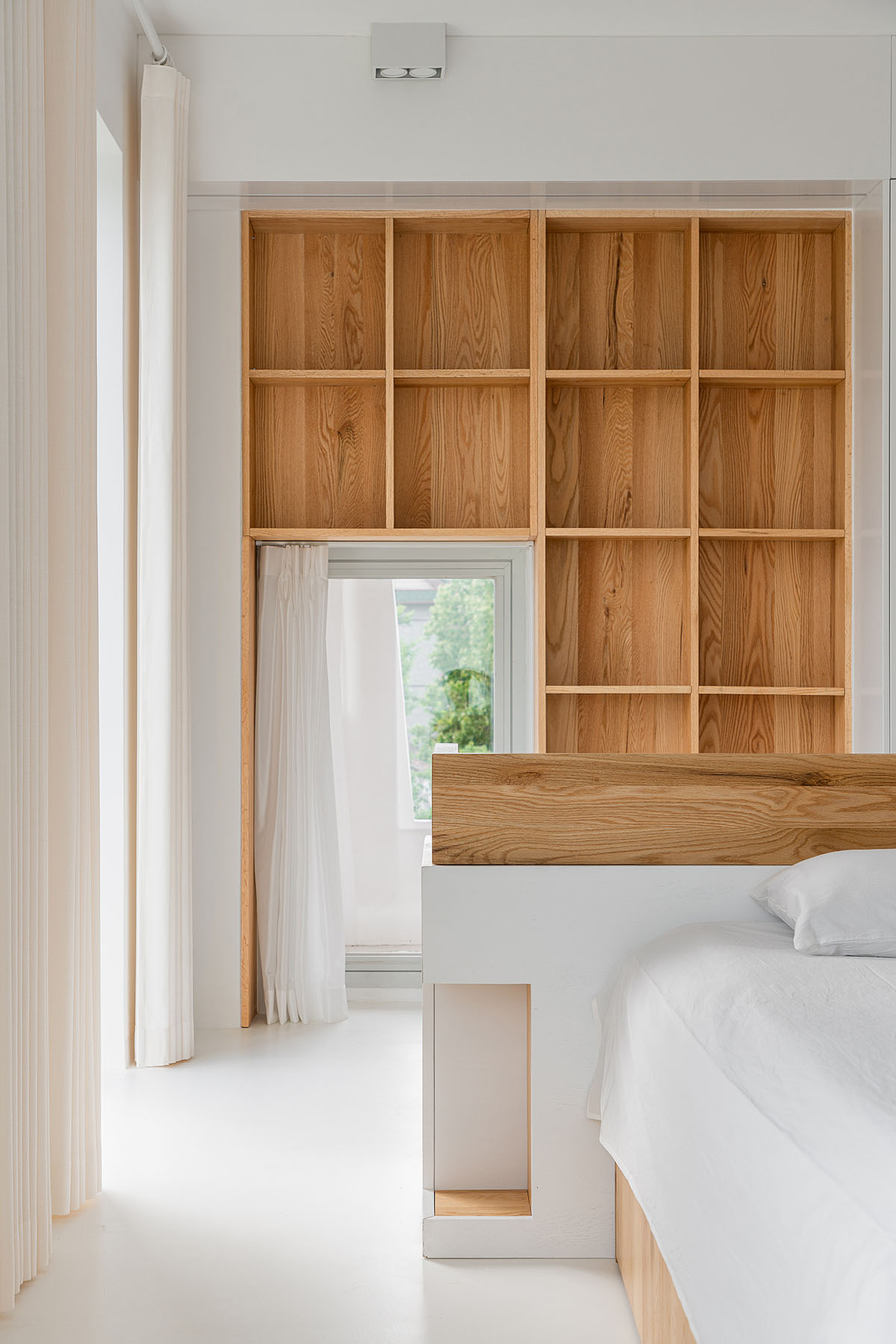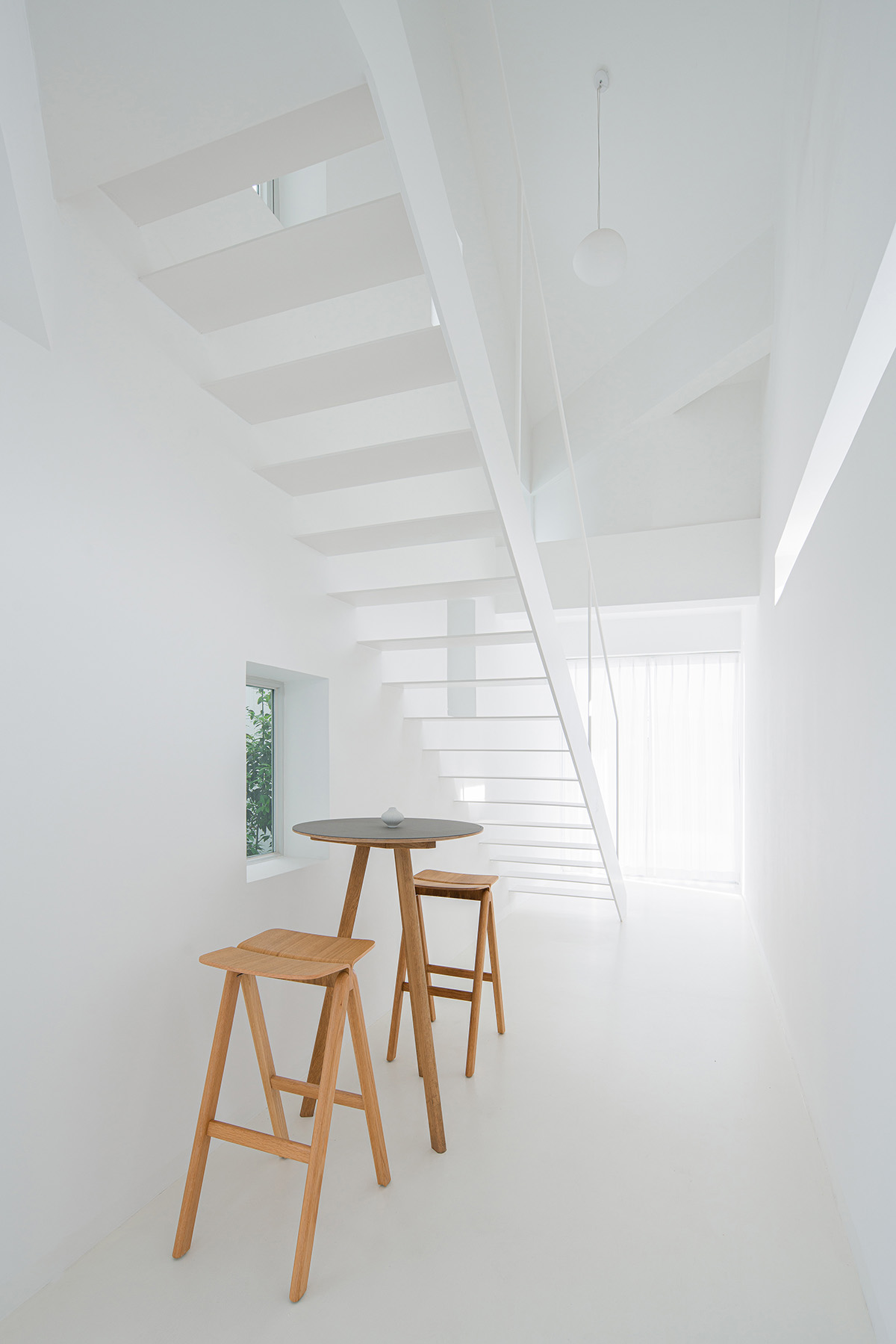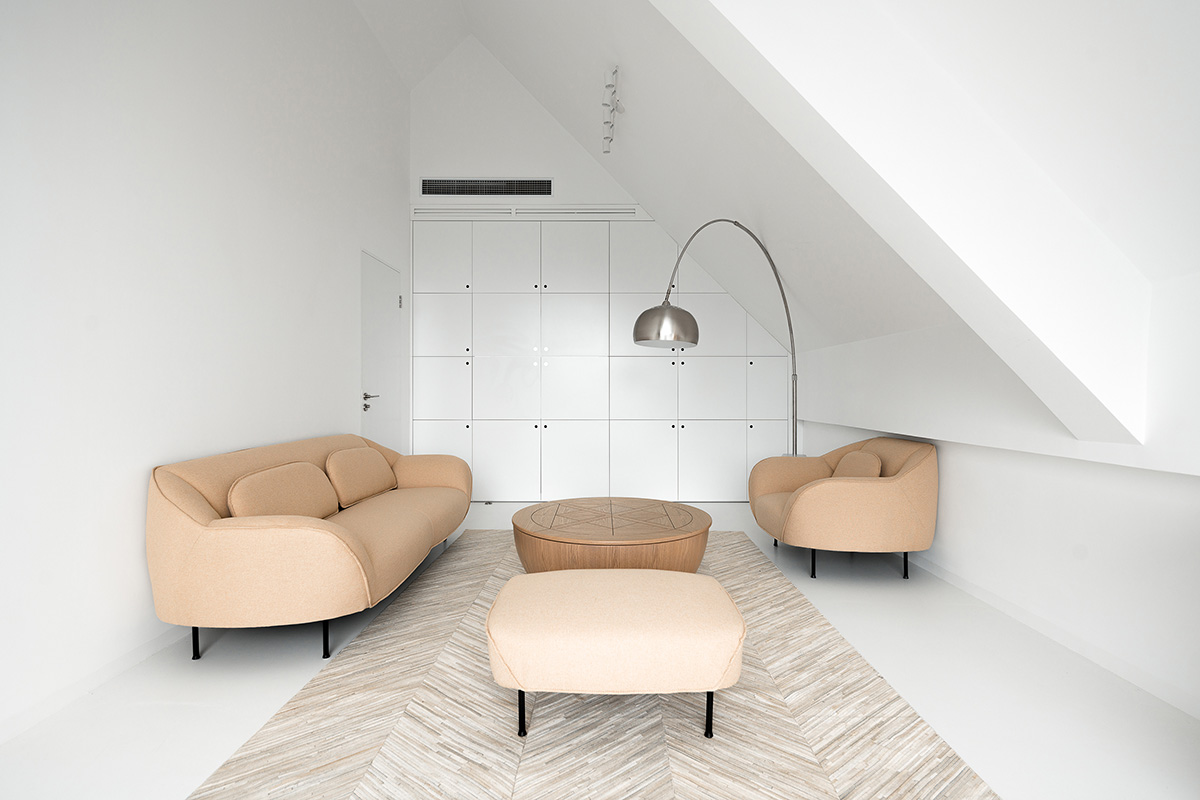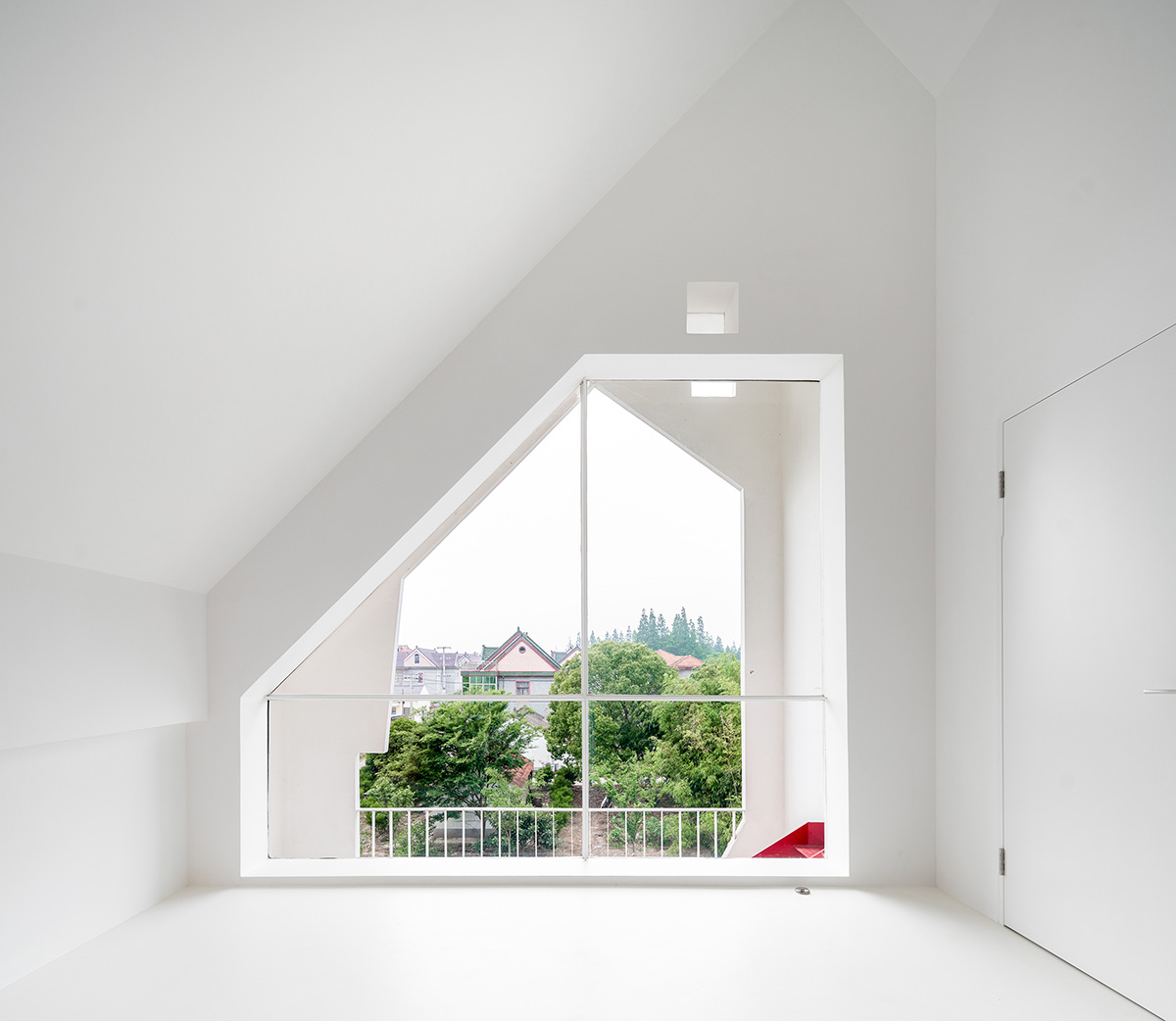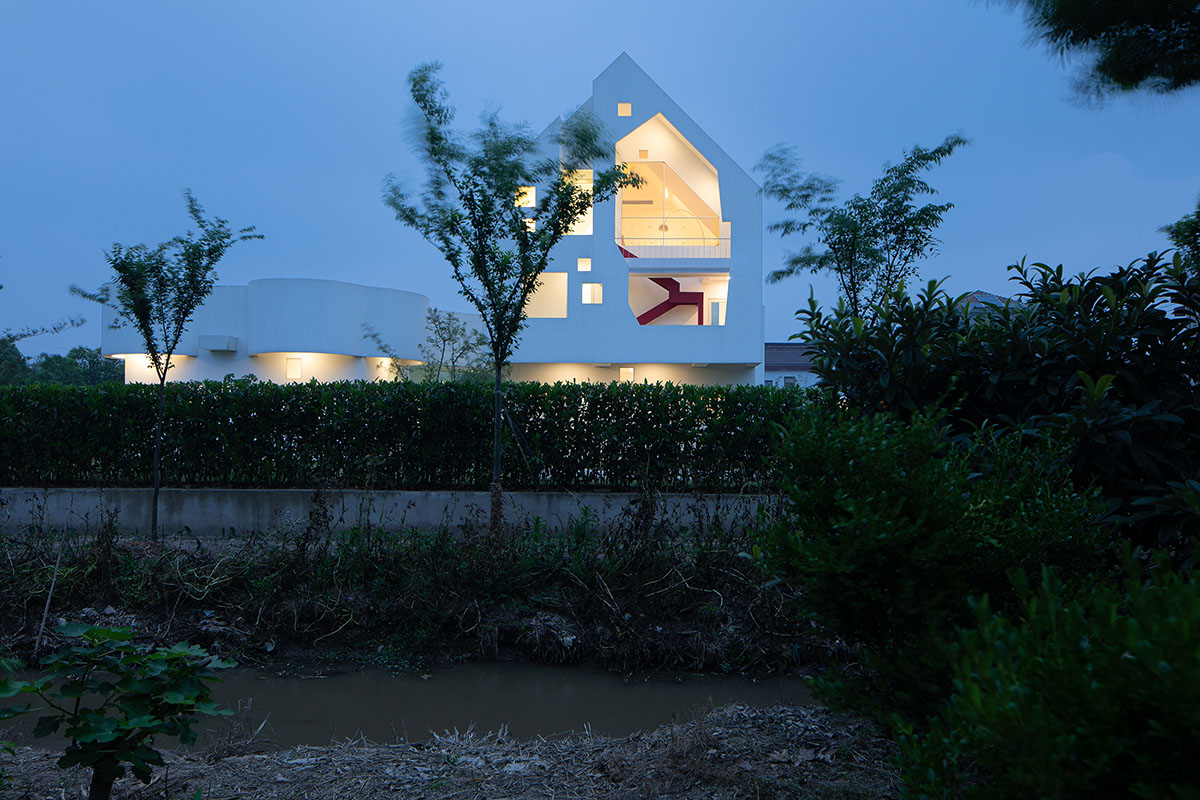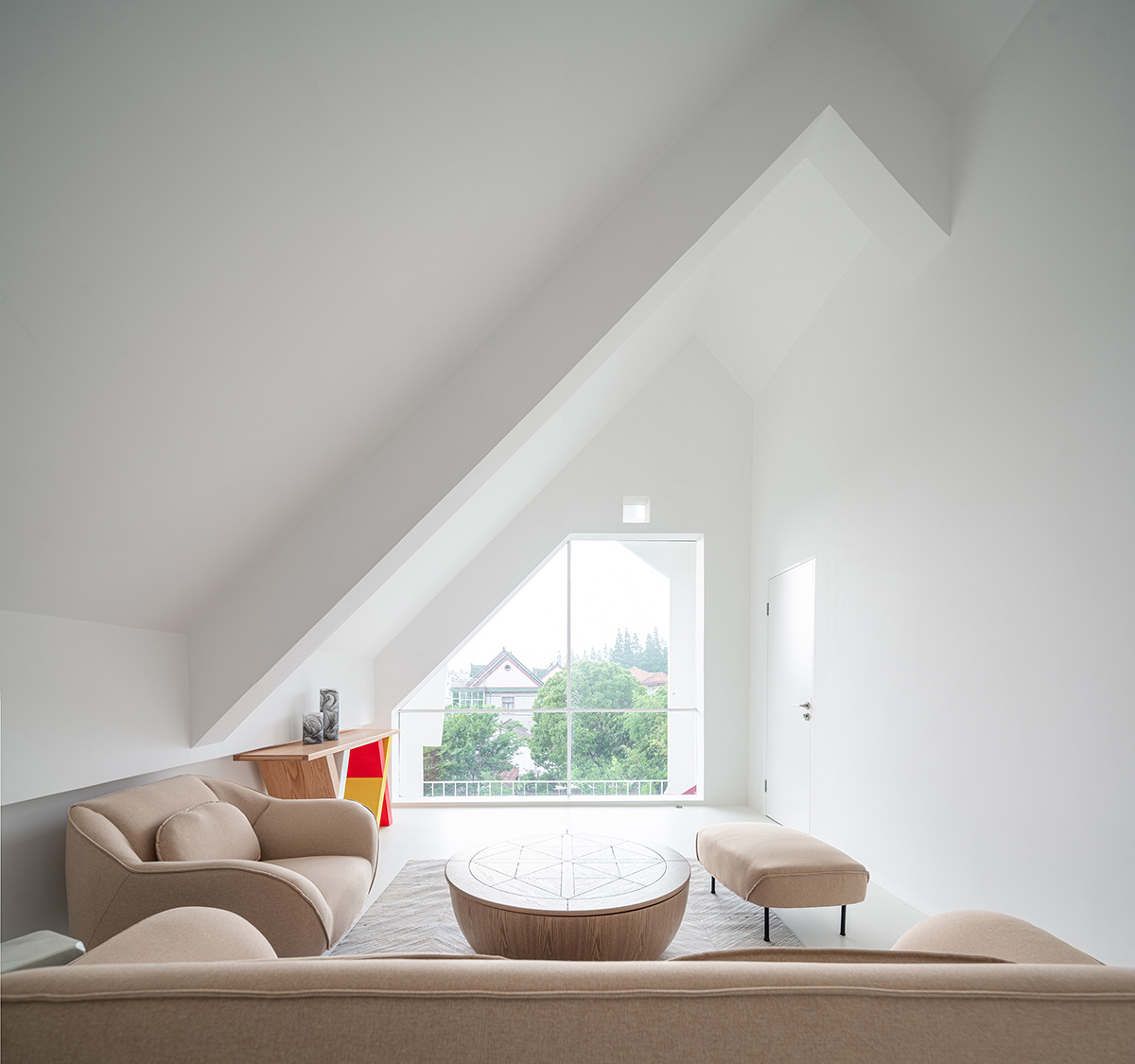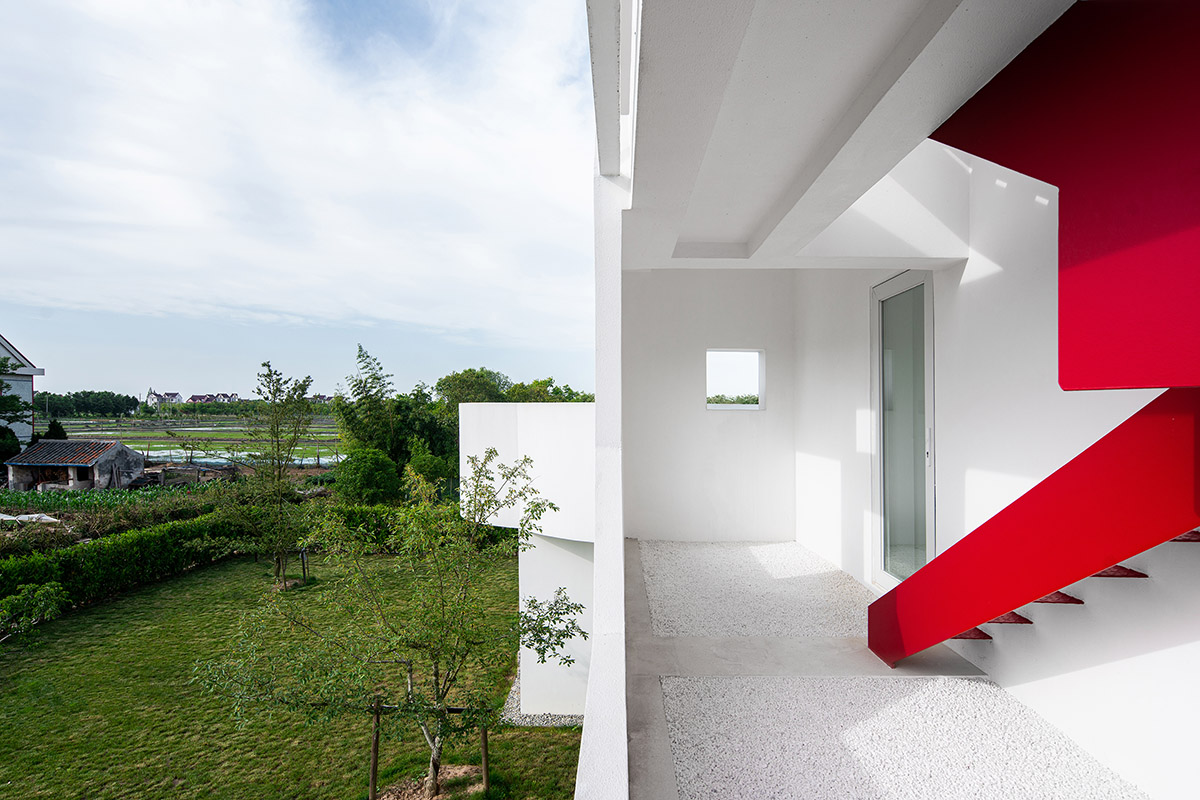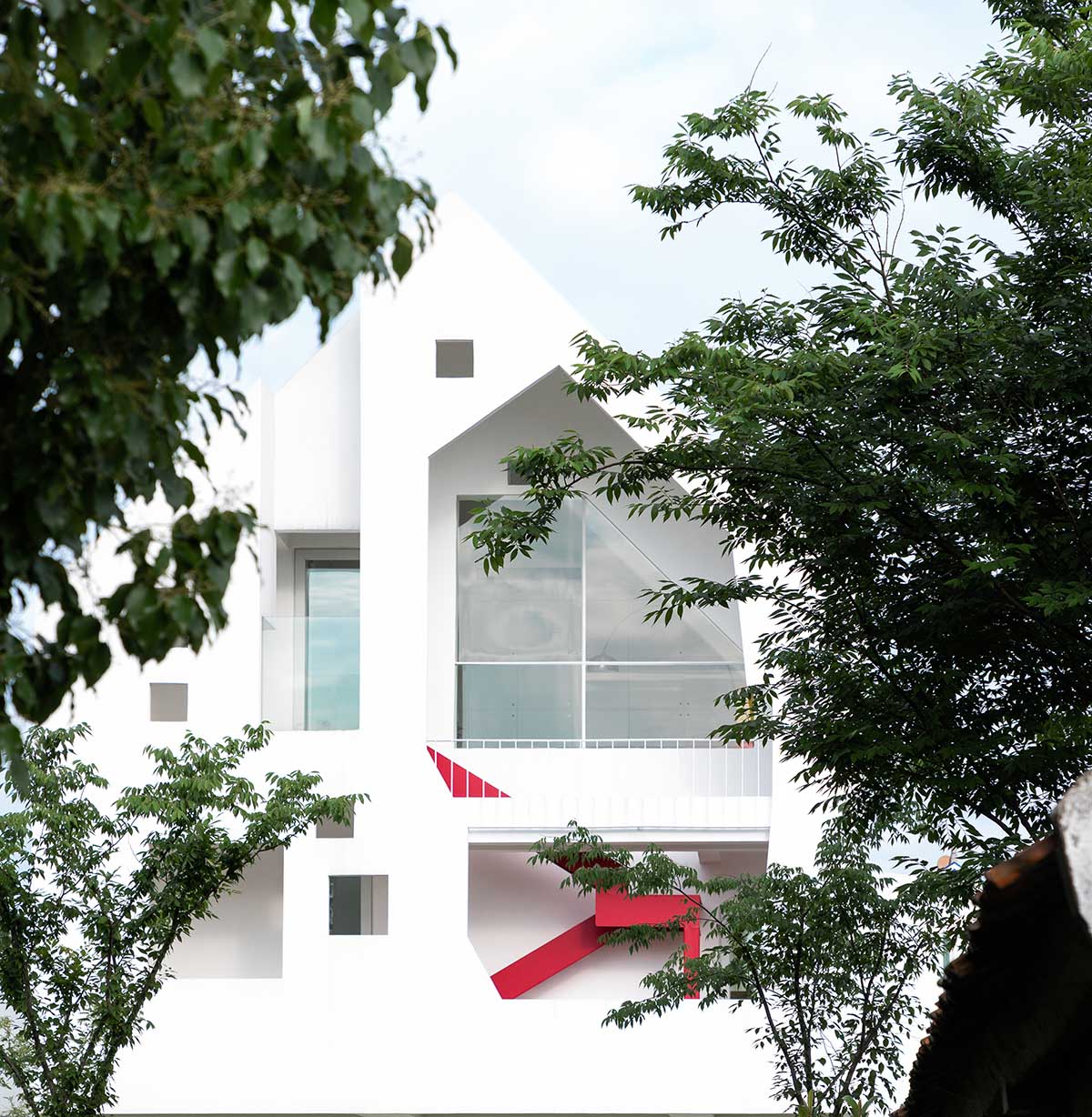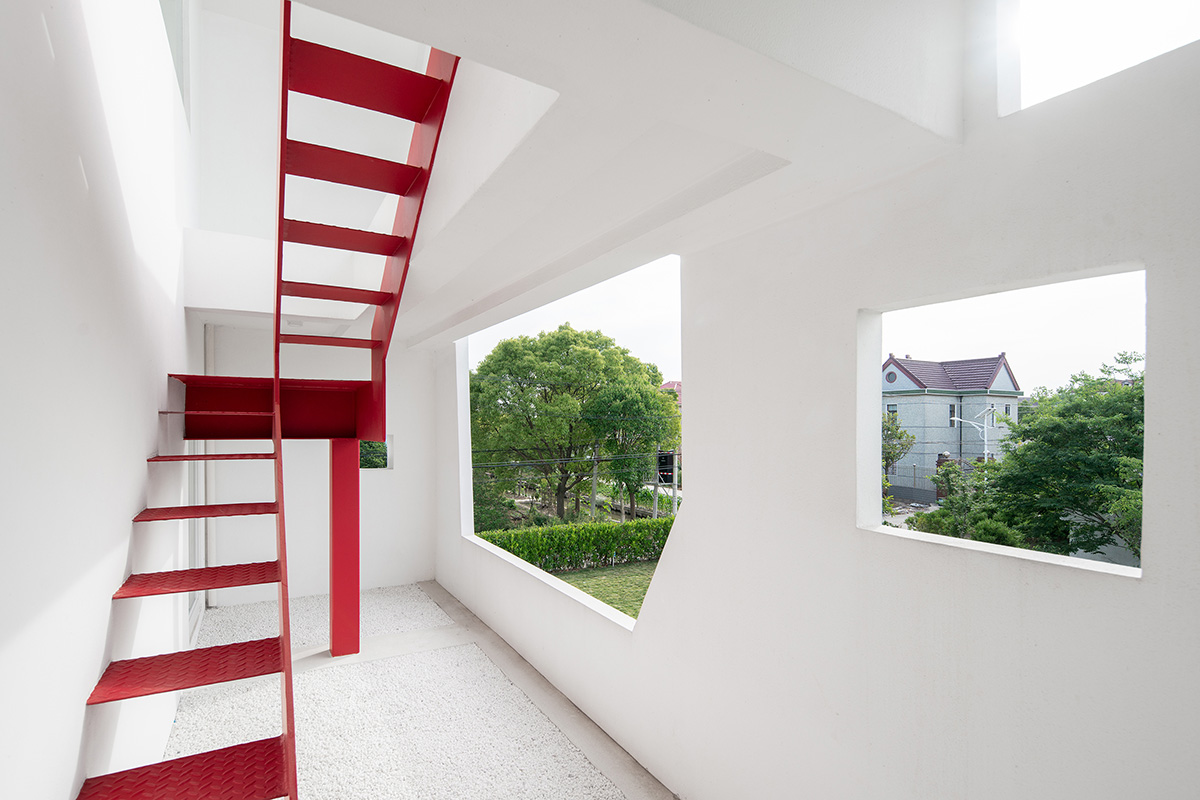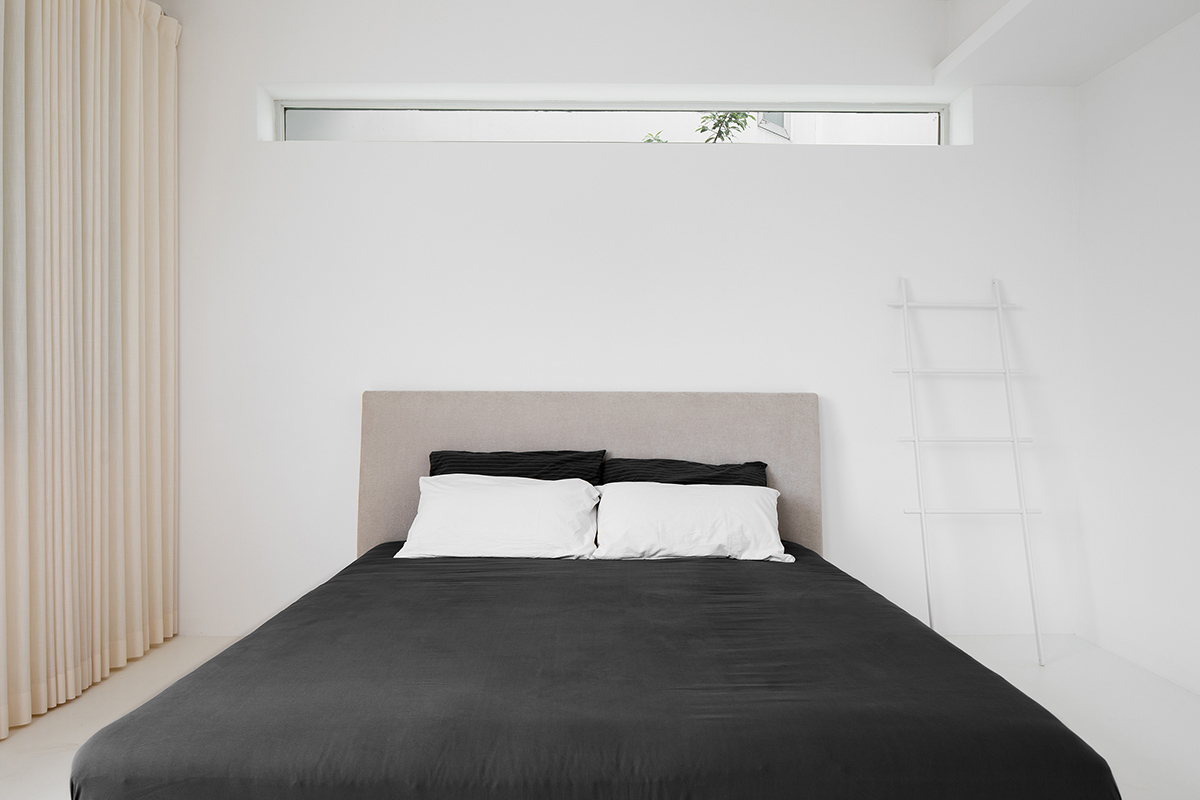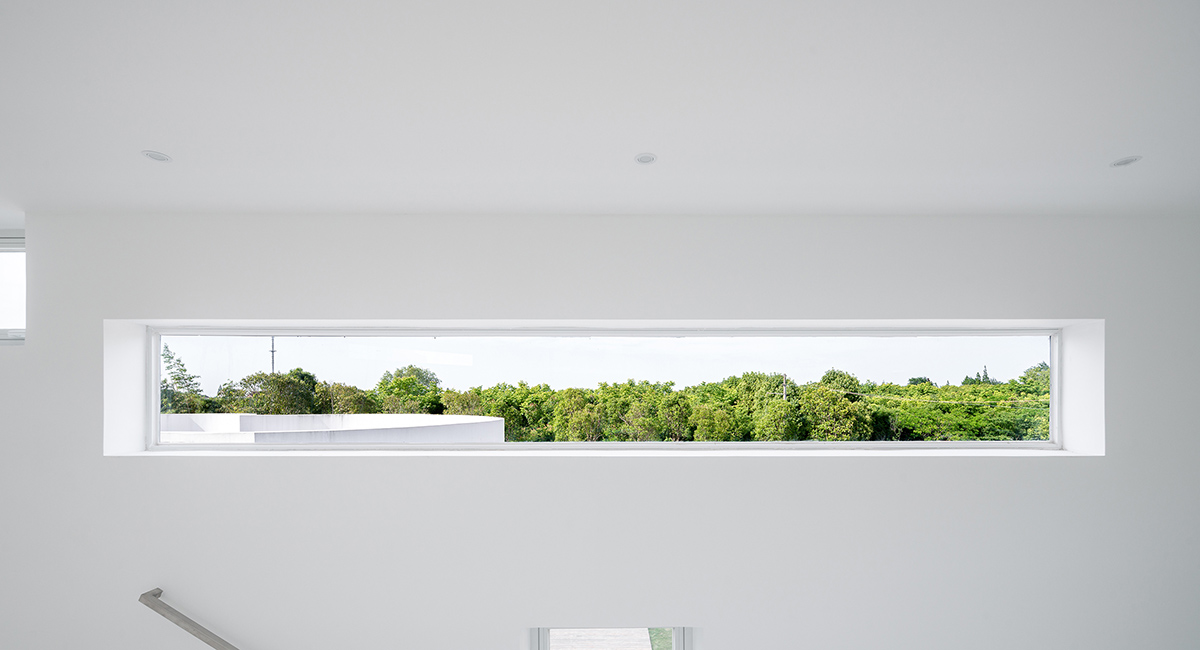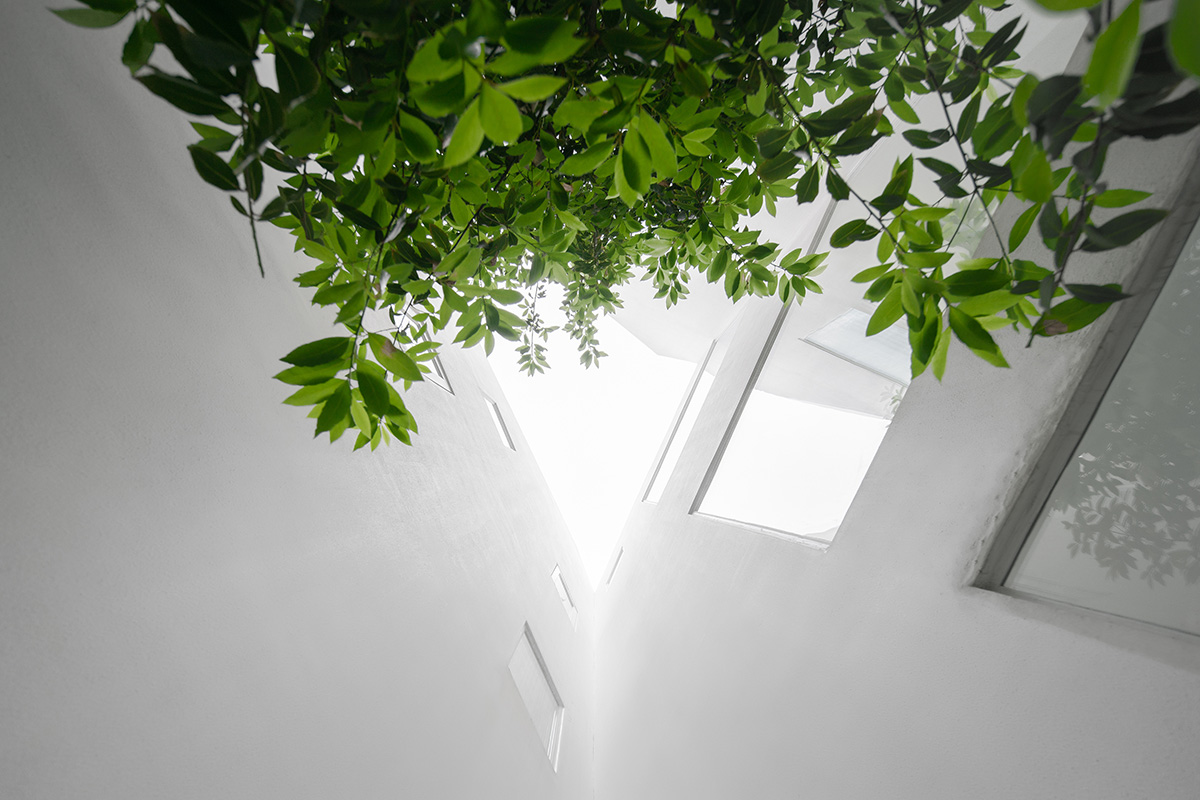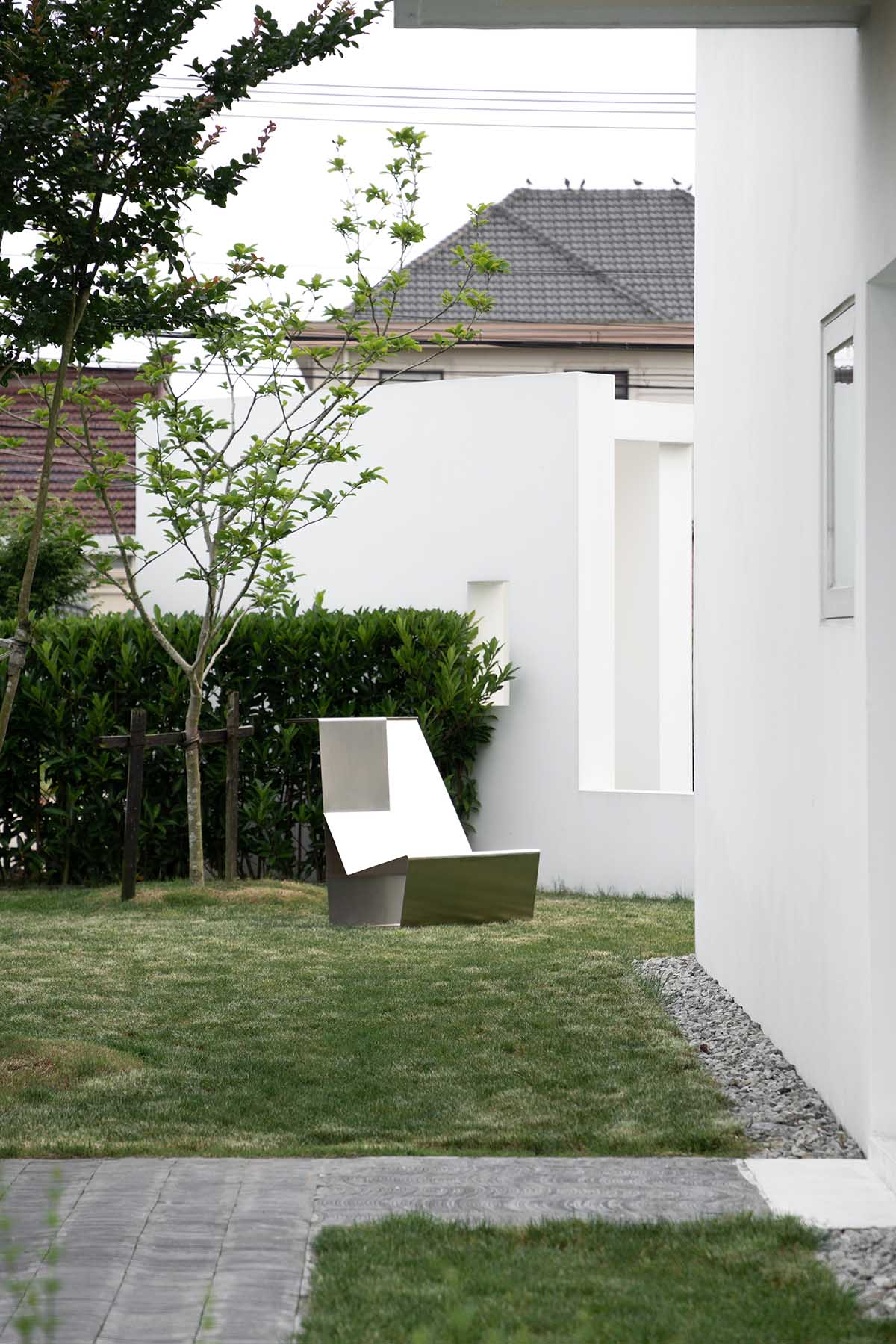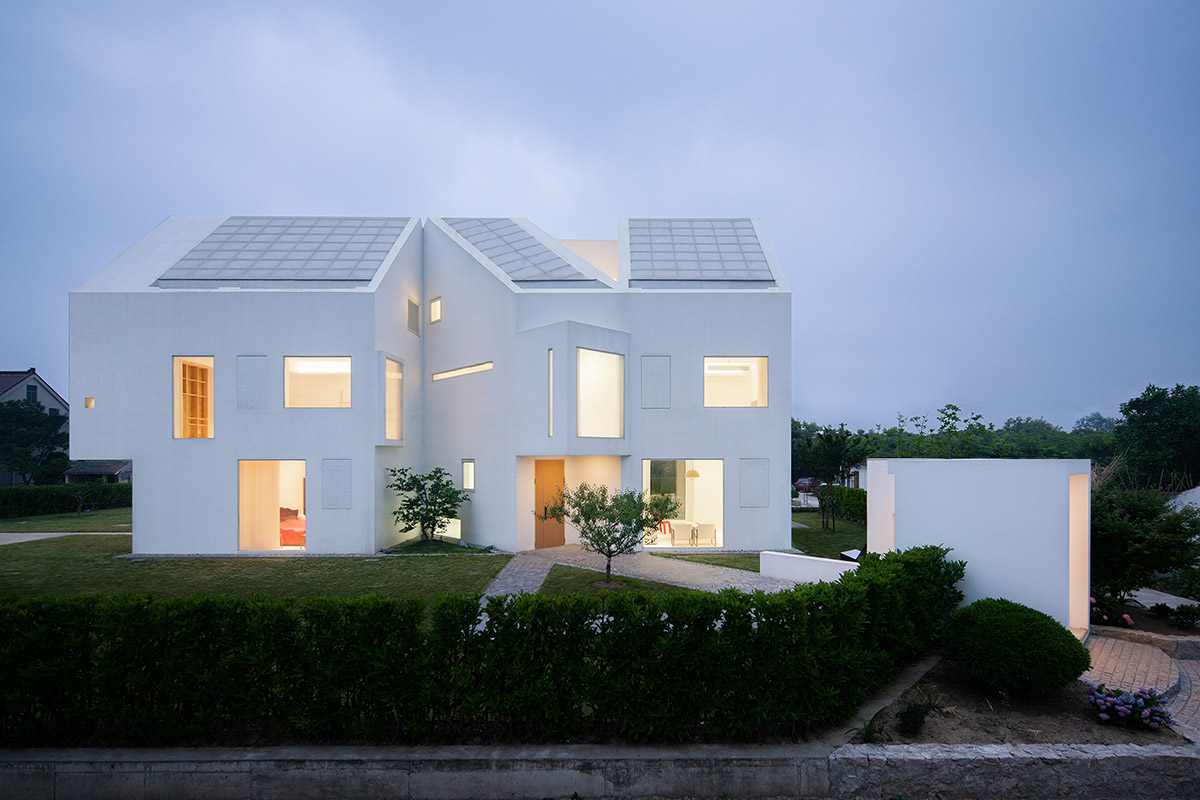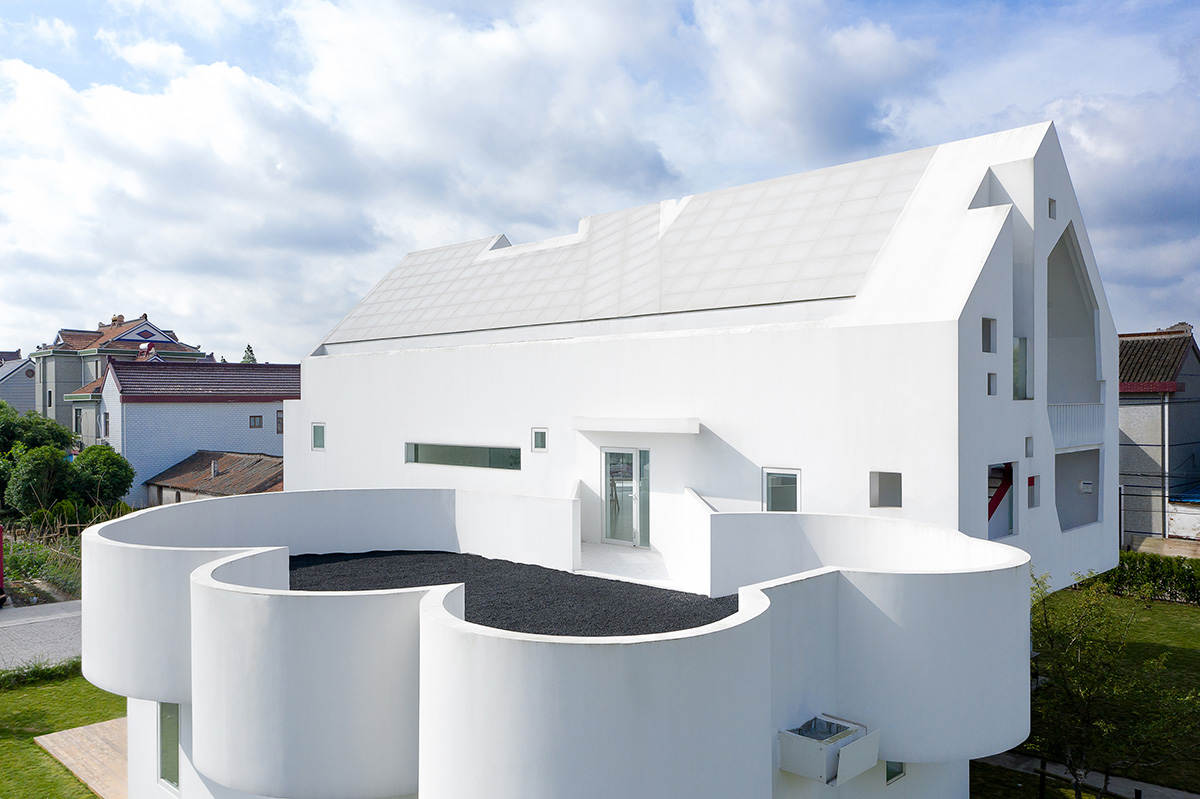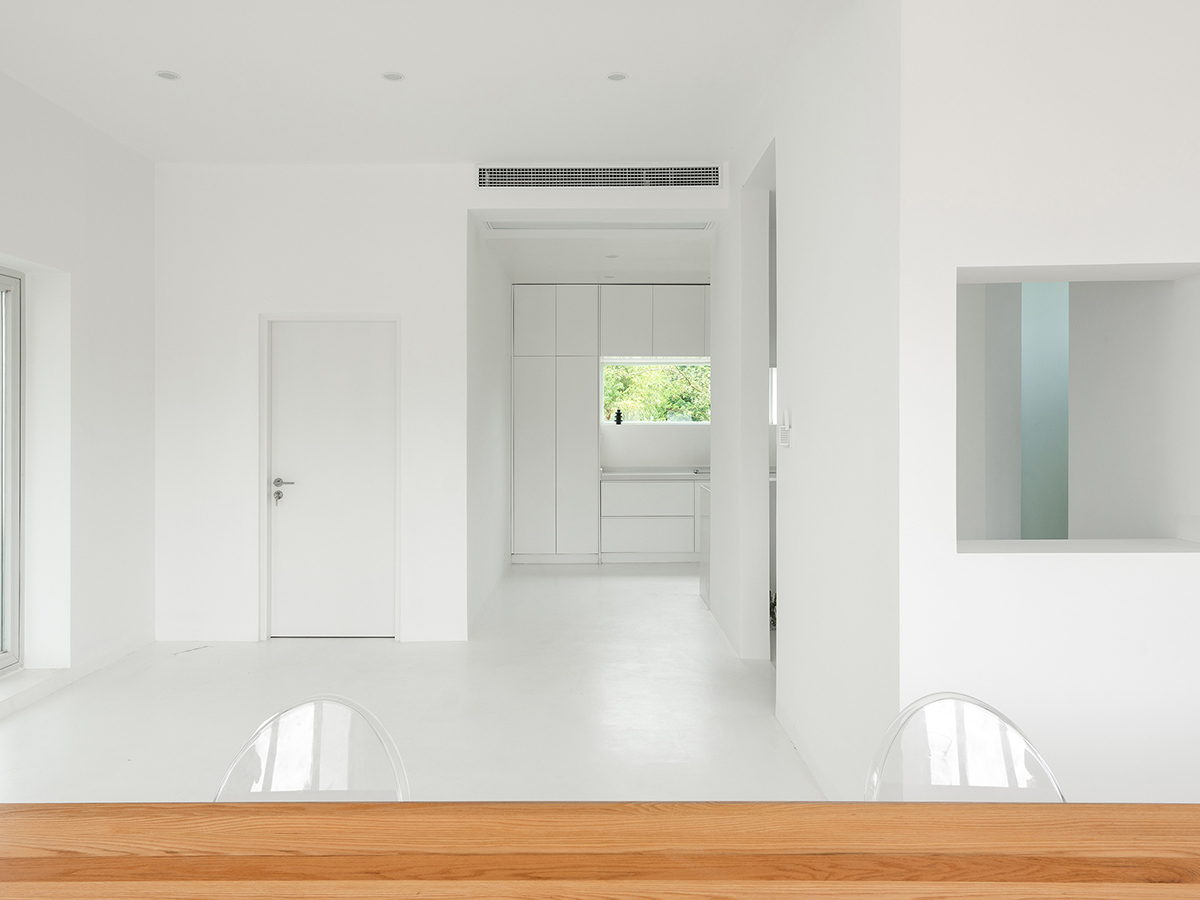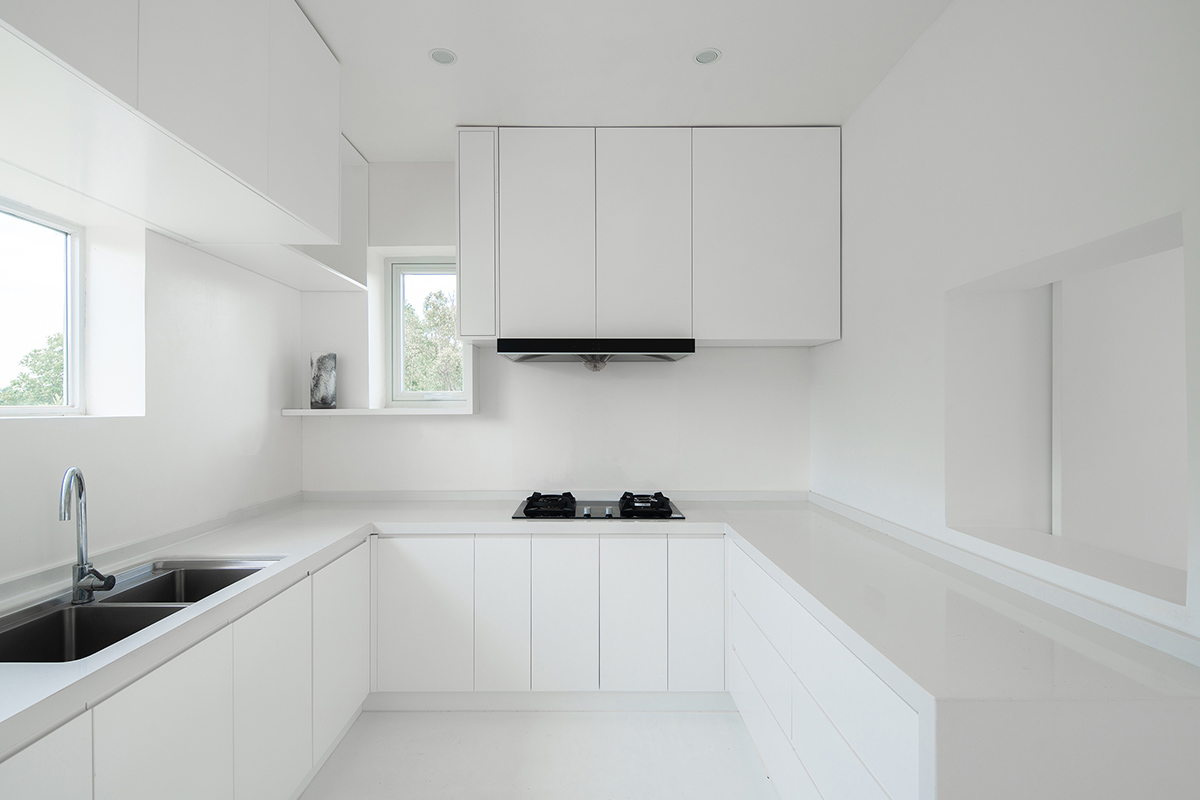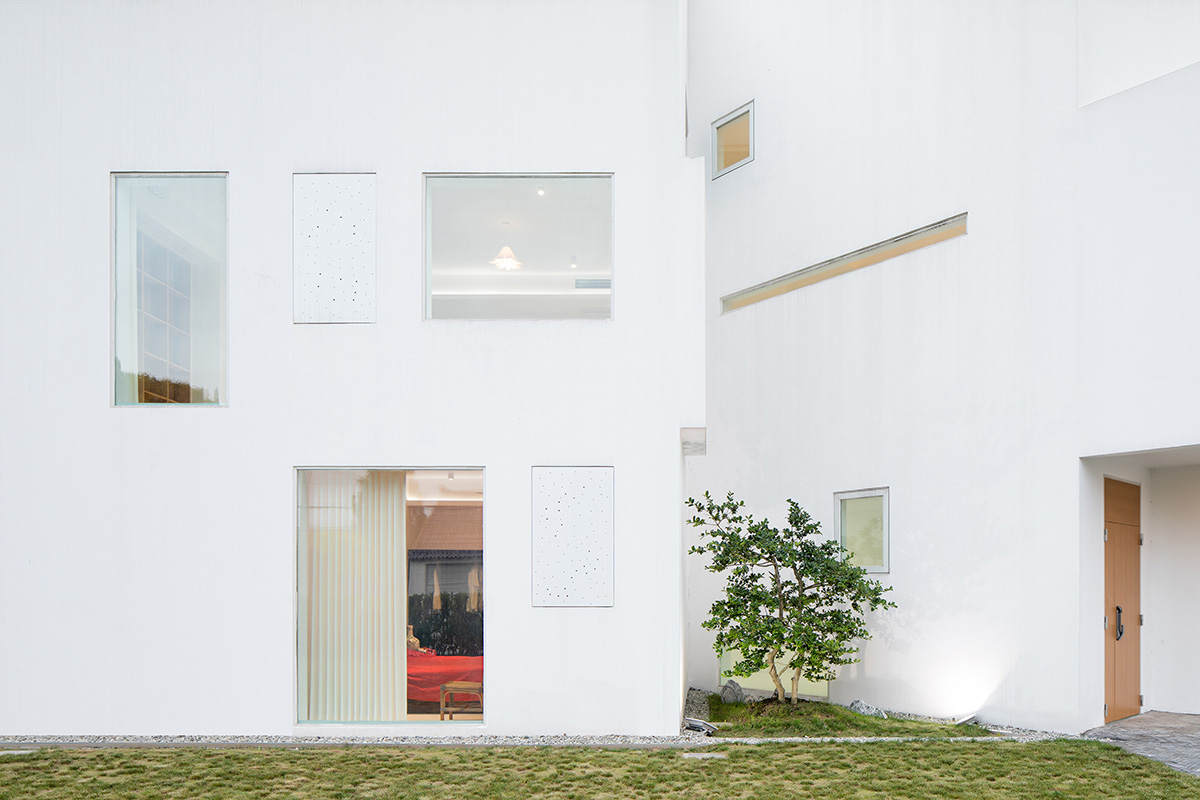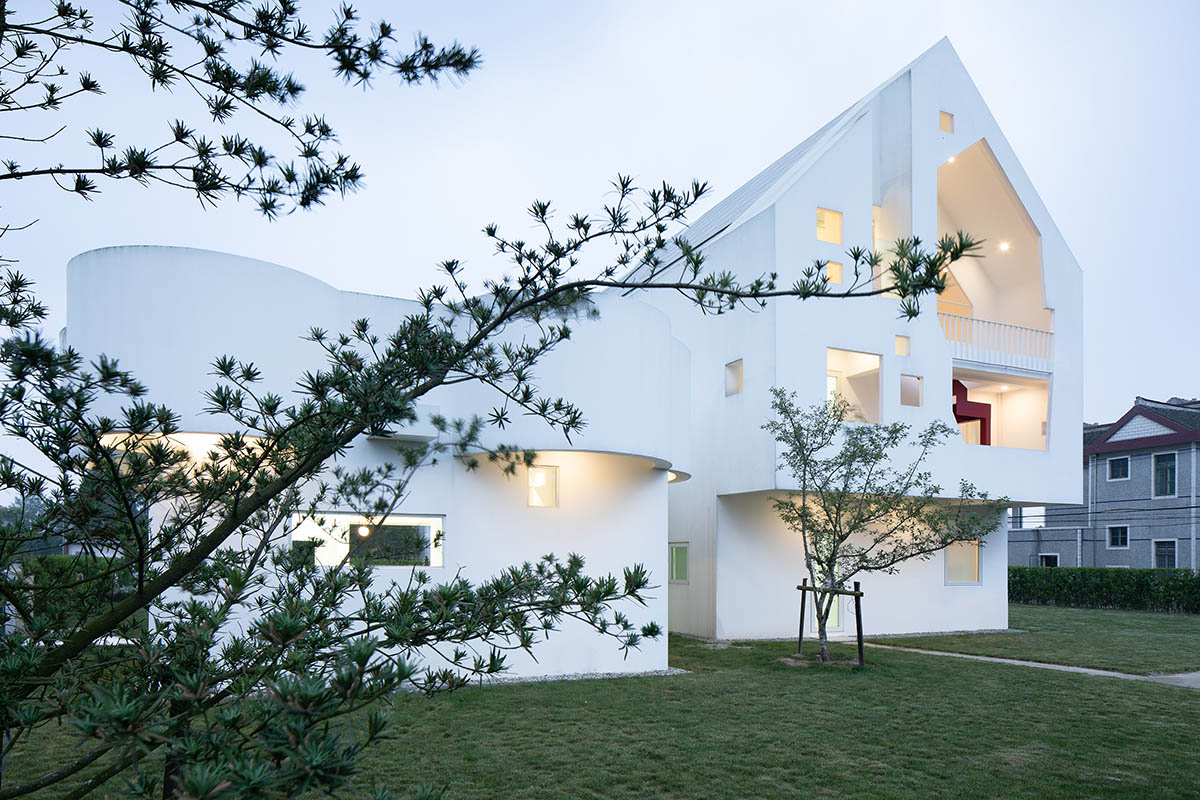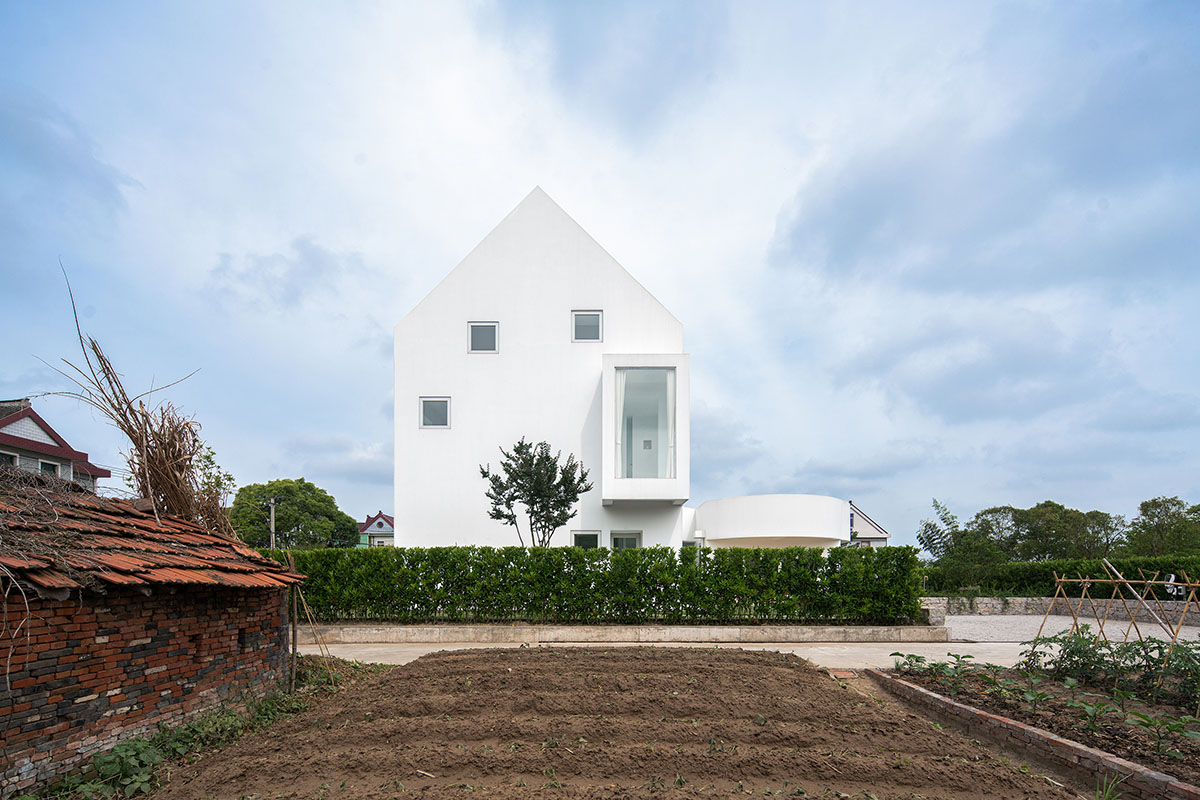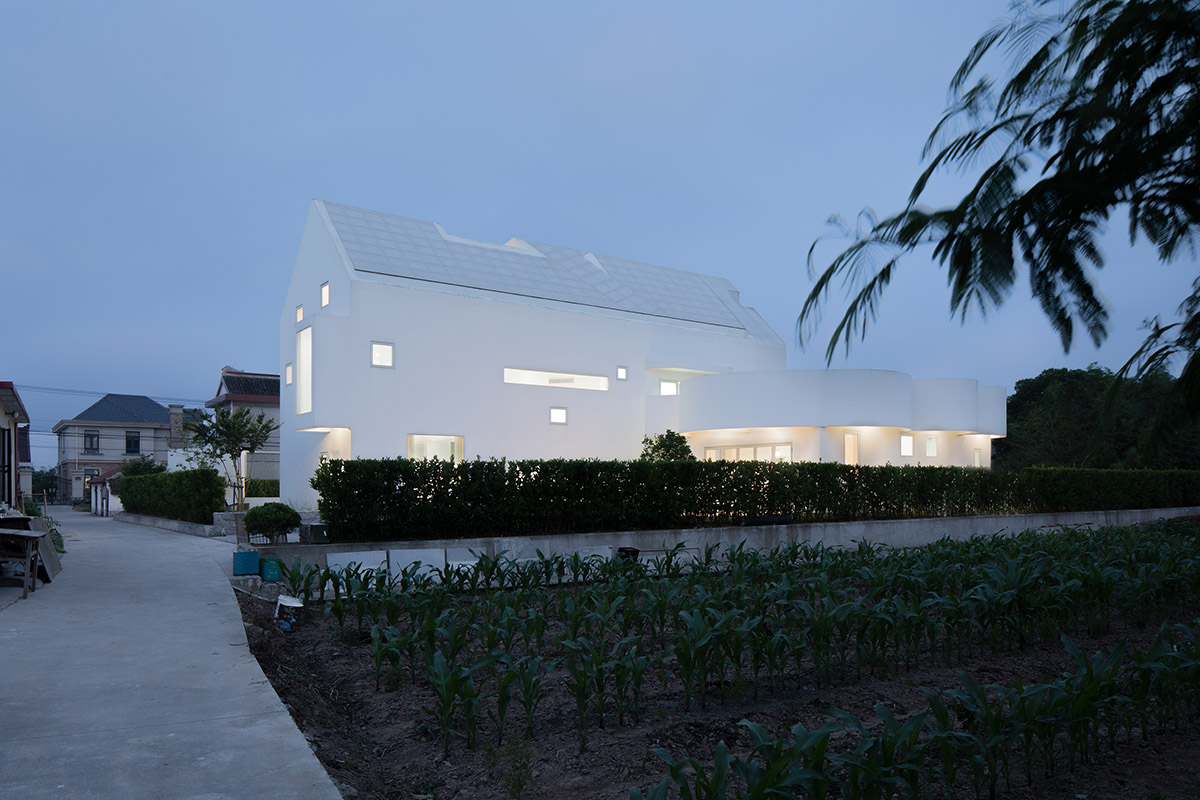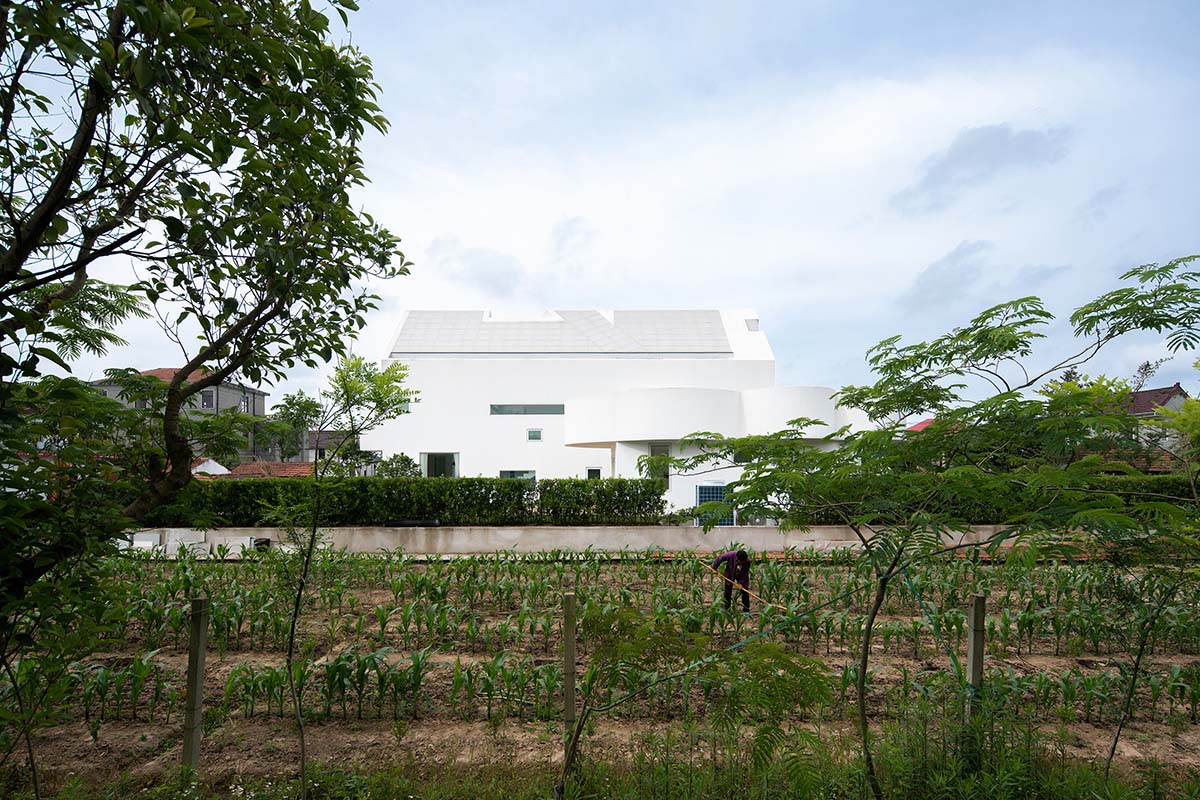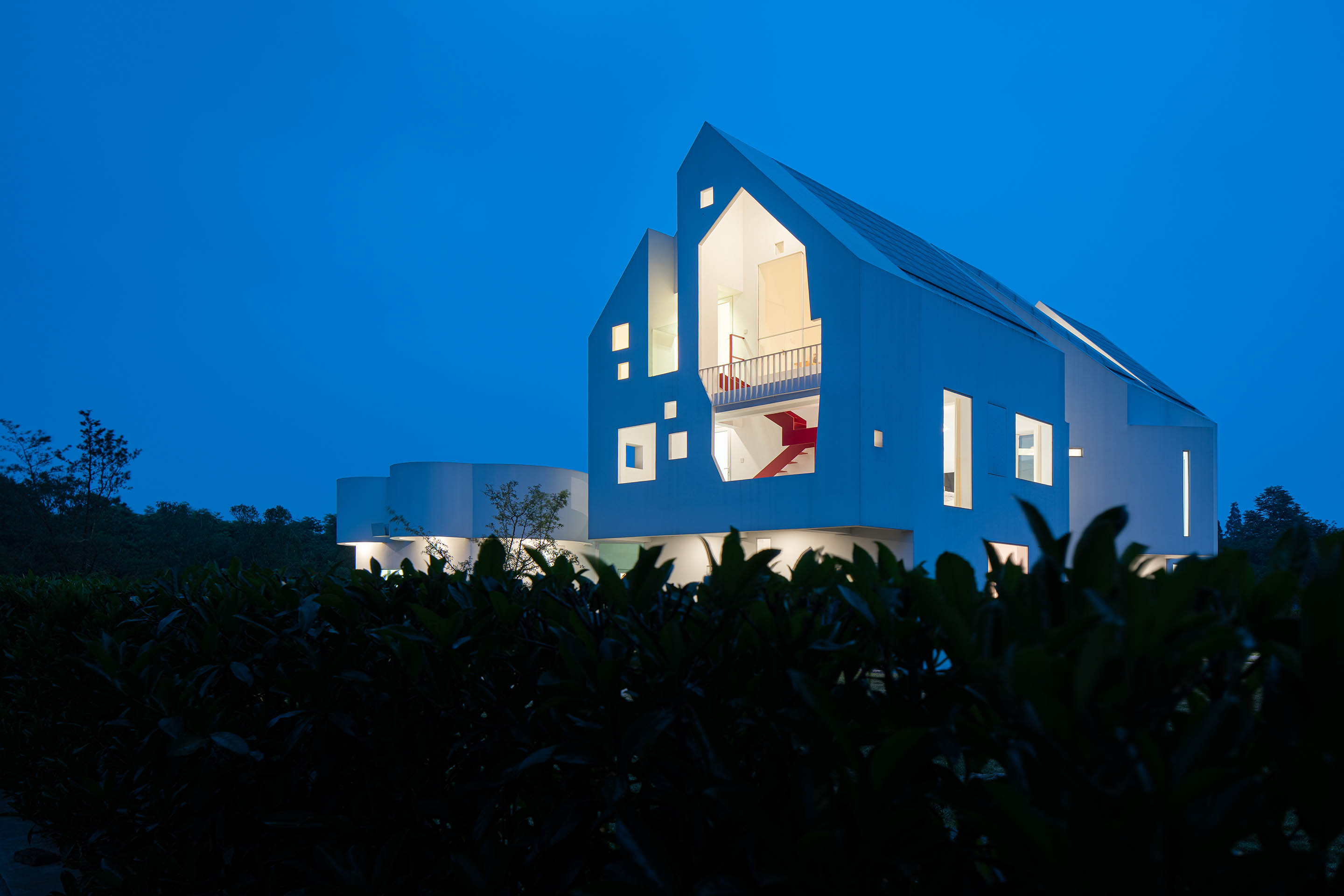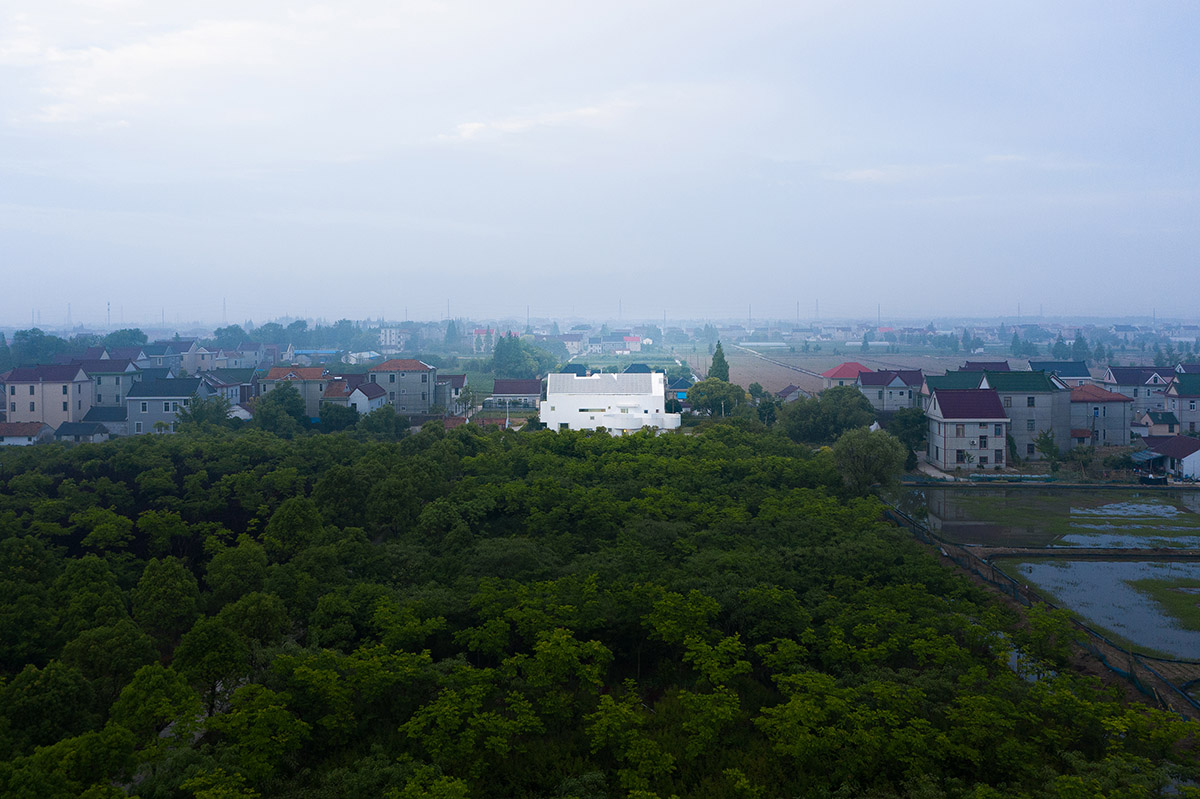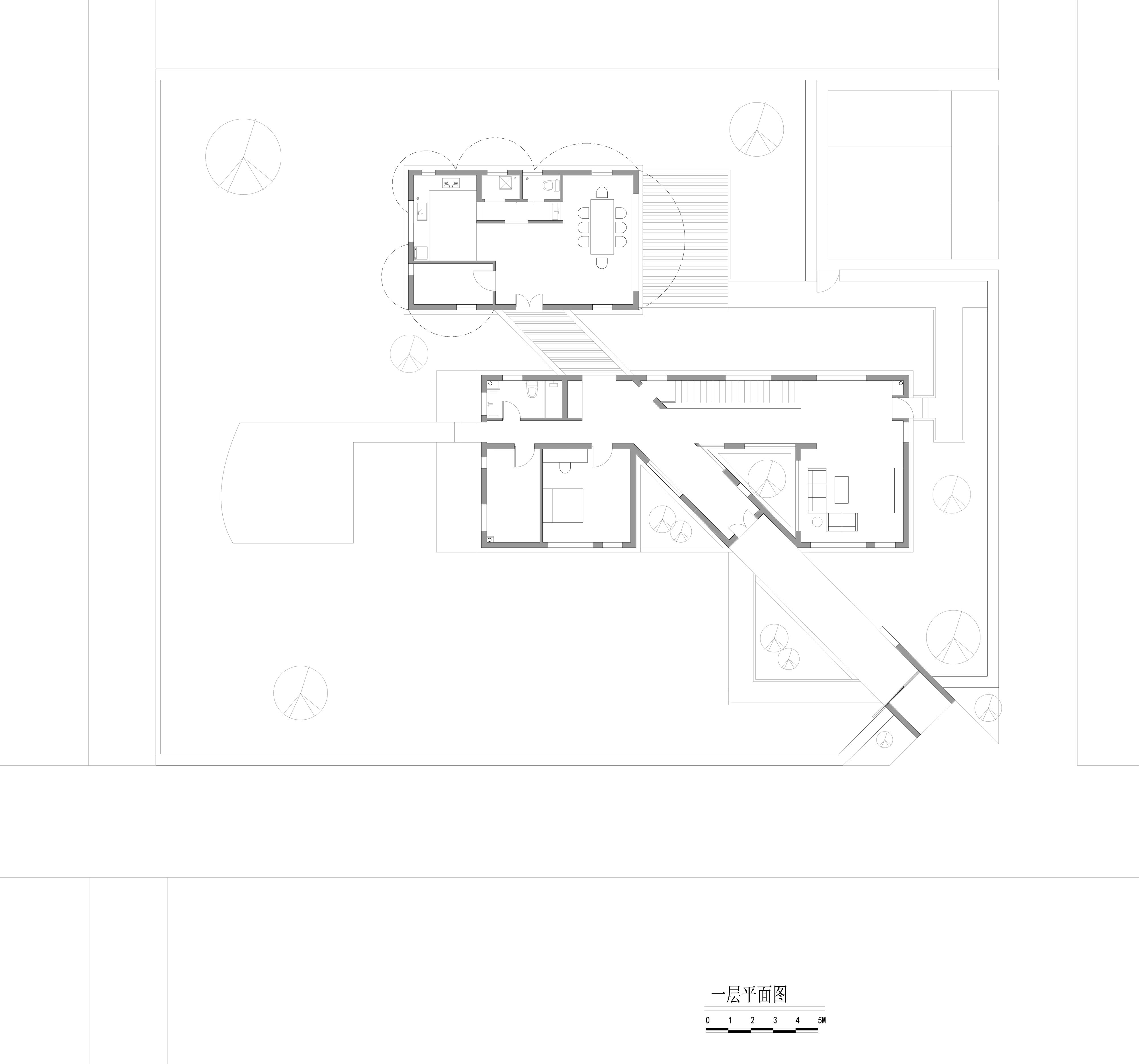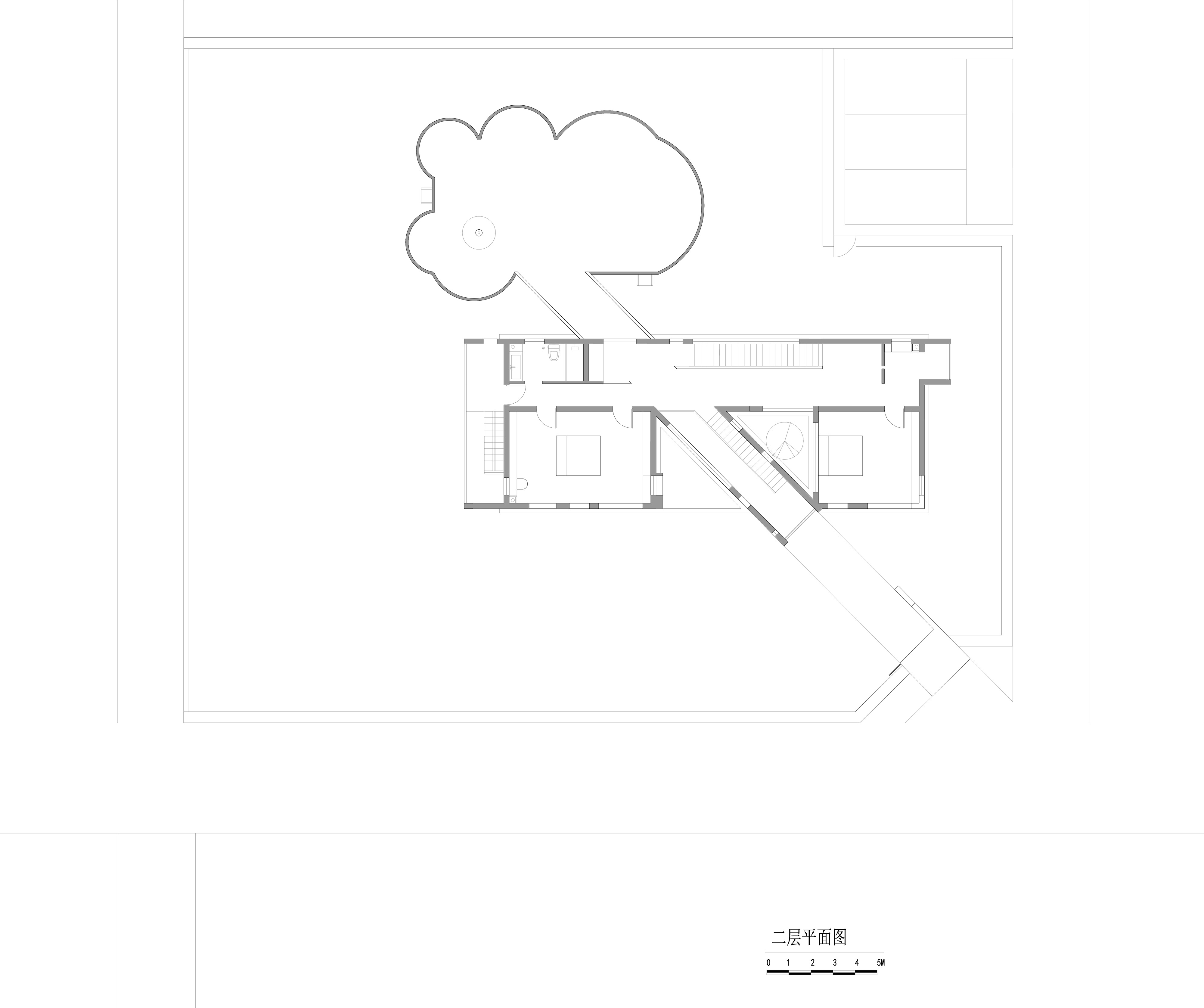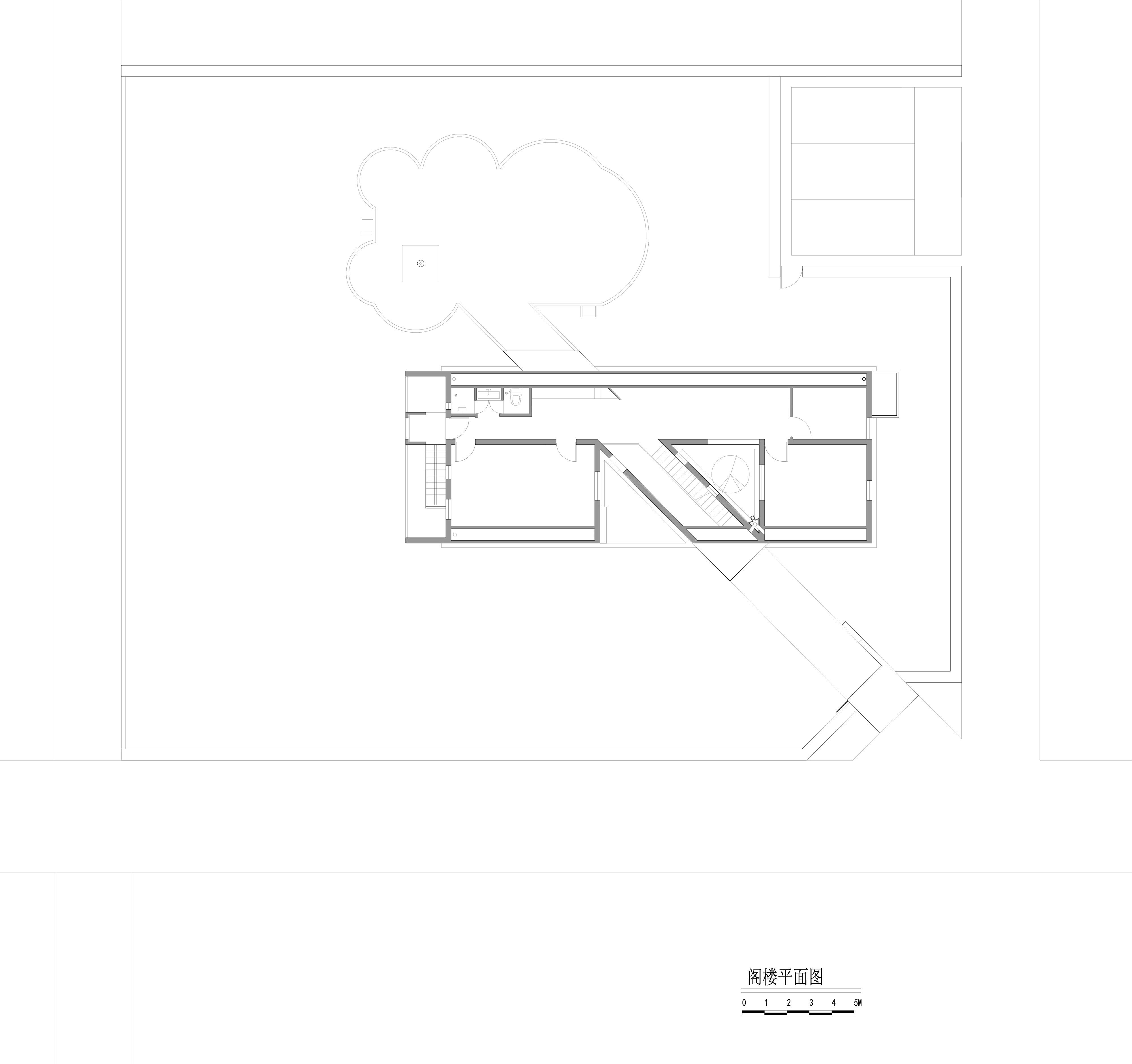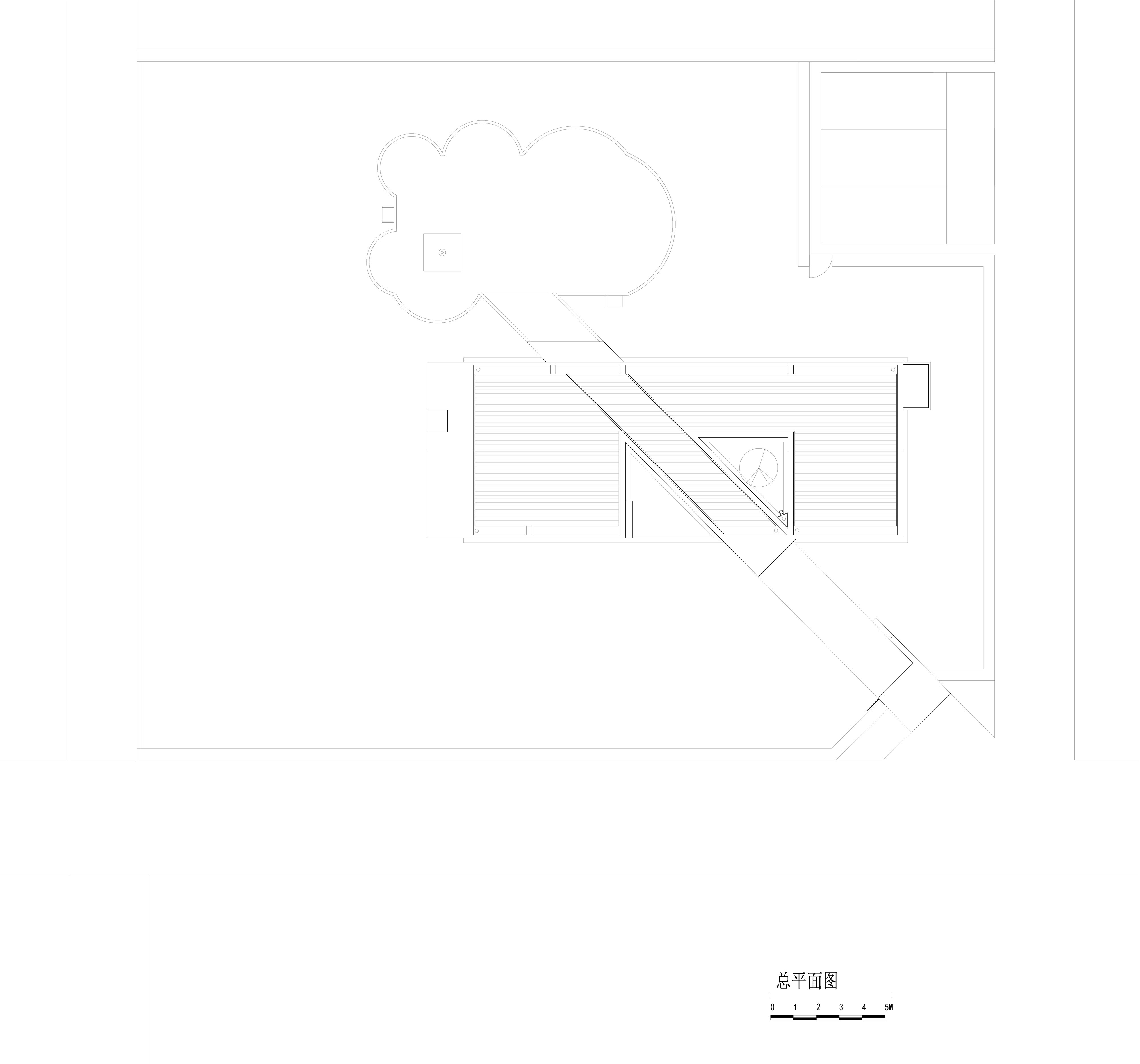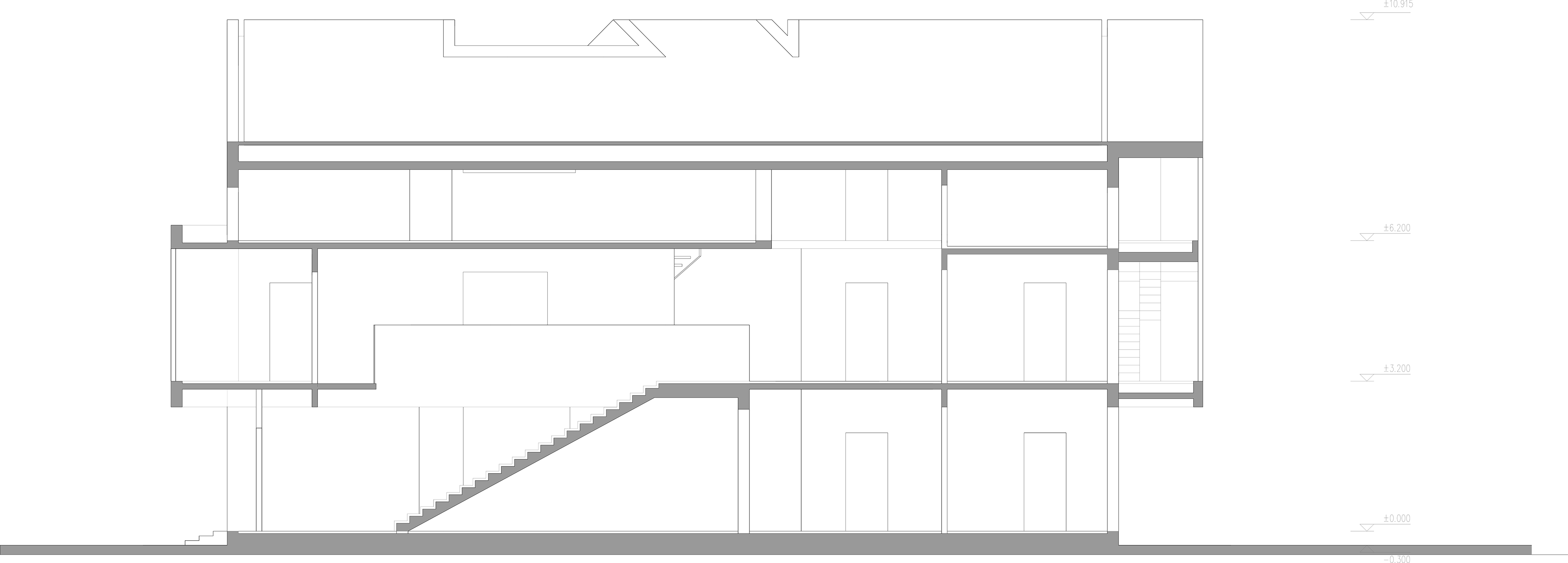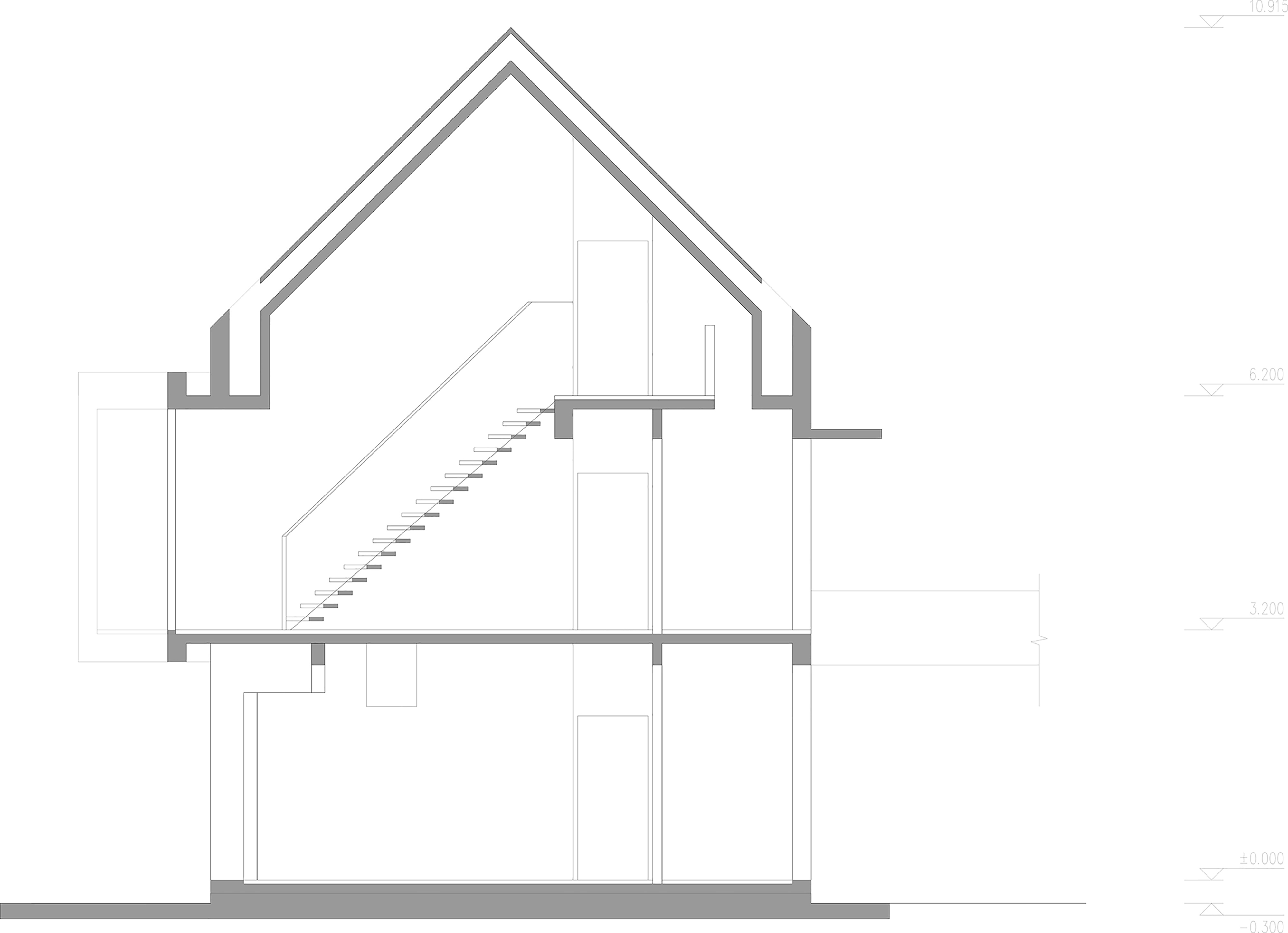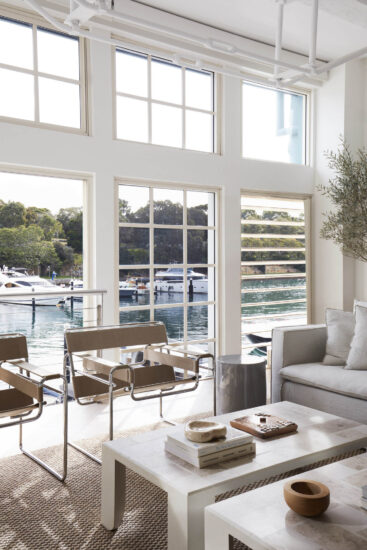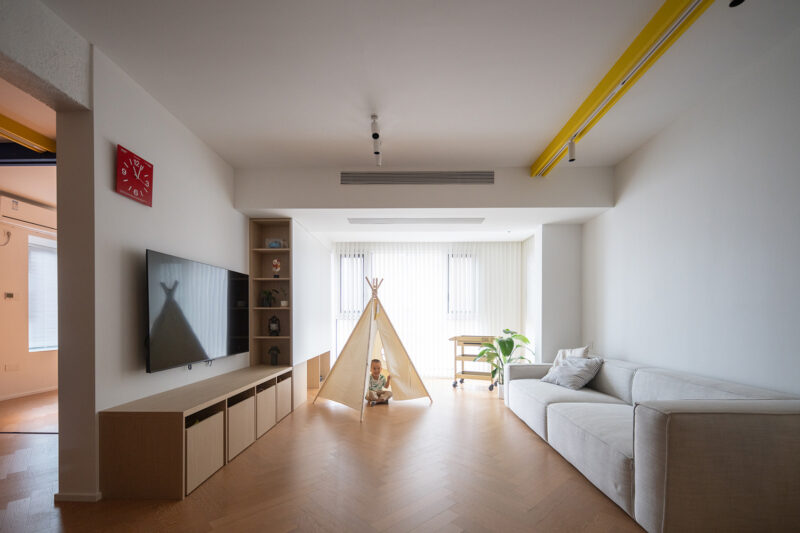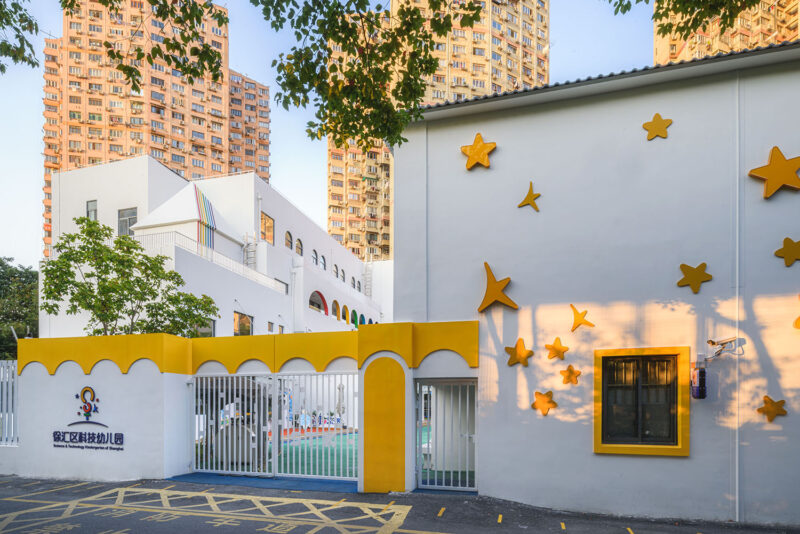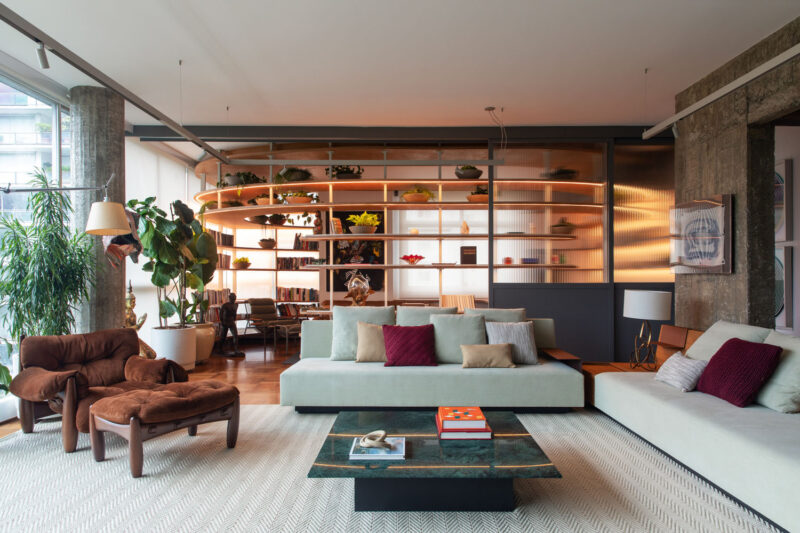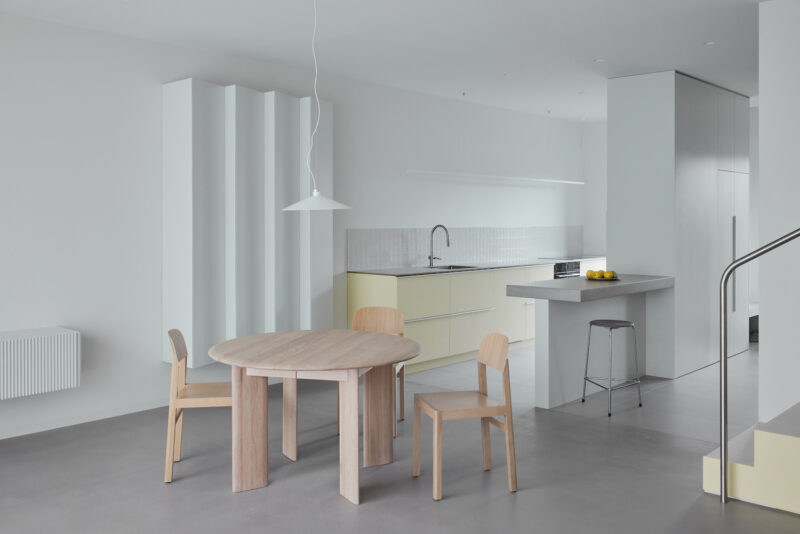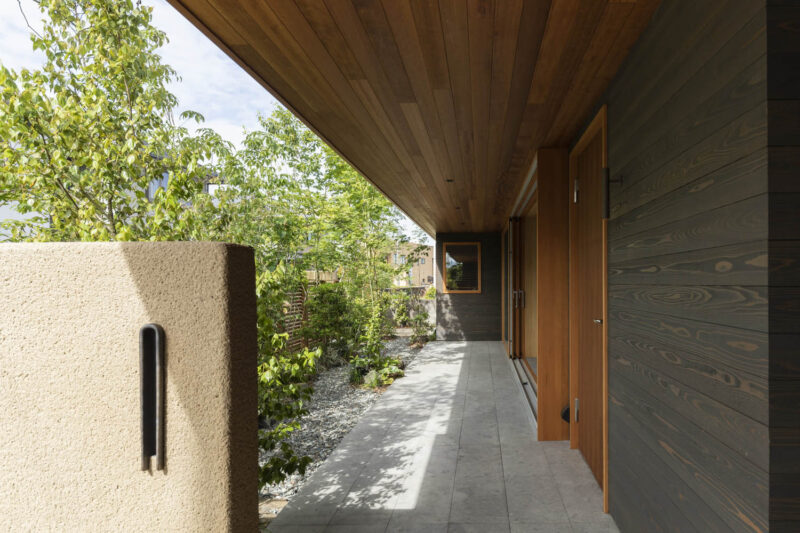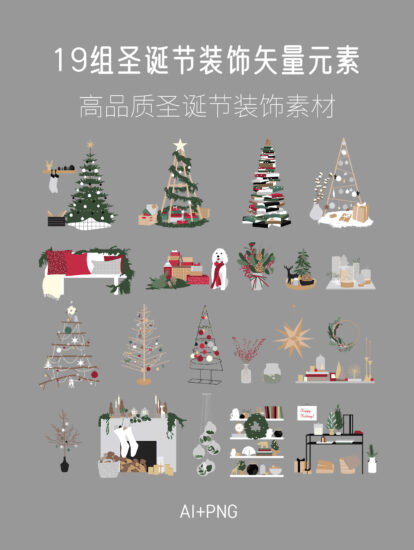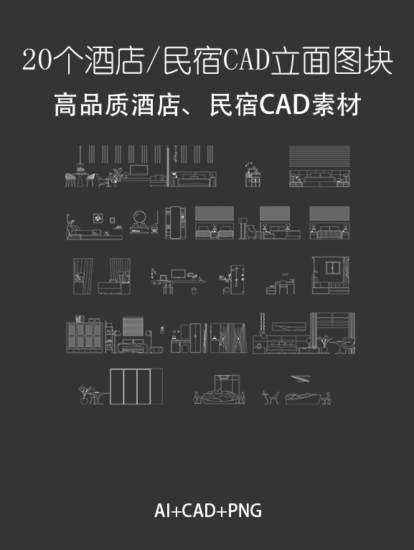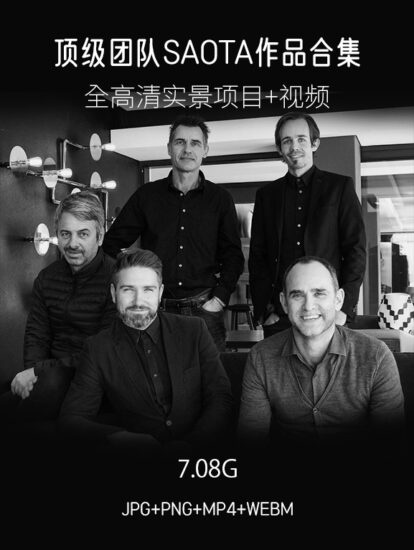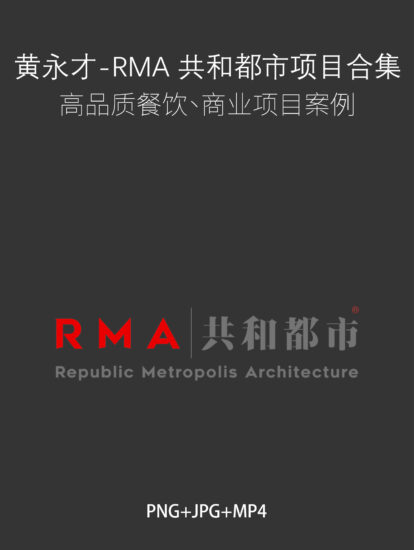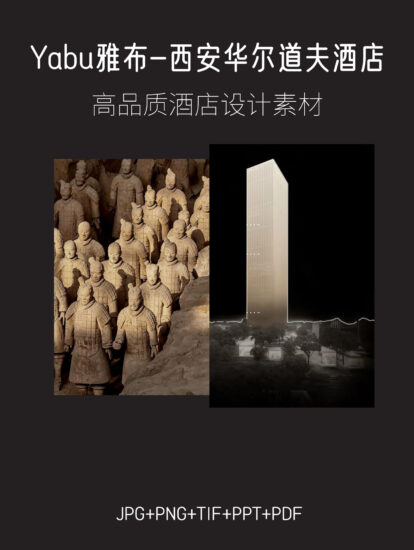全球設計風向感謝來自 元秀萬建築事務所(AMS) 的住宅空間項目案例分享:
∇ 屋頂平台看北麵樹林仿佛漂浮在森林之上 The roof terrace looked to the north as if the trees were floating above the forest ©呂曉斌
∇ 全景鳥瞰 Panoramic bird’s eye view ©呂曉斌
∇ 鳥瞰 Bird’s eye view ©呂曉斌
當我們徘徊與過往的鄉村或城市的房子永遠不能超出那被限定的框子裏,而人們希望的總是永遠的回歸的旅行,這個住宅就是讓你在原地無限的遊牧 …..
– 元秀萬
If we wander through the houses in past old countryside or the city, we will never jump out of the limited frame. People always want to return forever, this house is to let you nomad in the place….
– sooman
∇ 鄰裏看建築外觀 Neighbors look at the exterior of the building ©呂曉斌
∇ 夜景西立麵 Night view west facade ©呂曉斌
∇ 外立麵透視External perspective ©呂曉斌
陸宅是元秀萬為在上海居住的三口之家設計的周末住宅,建造在上海崇明島上。老房子是上世紀八十年代的建築,需要把原建築拆除後原地新建。根據老房屋的體量和麵積,結合當地土規首層要控製在一百九十平米、樓層是二層半的坡頂結構,輔房是一層建築麵積六十平米。
L HOUSE, sitting on Chongming Island in Shanghai, is designed by Xiuwan Yuan for families of three to have fun on weekends. The old house (before refurbished) was built in the 1980s. We demolished the old house and rebuilt a new one. Combined with local land regulations and the height and floor area of the old house, the first floor should be controlled at 190 square meters. The total floors should be at two and a half. Therefore, we designed the main house with a sloping top structure, and a secondary house with the construction area of 60 square meters.
∇ 夜景,田地裏看建築 Night view, buildings in the field ©呂曉斌
∇ 鄰裏田地看建築 Look at the buildings in the neighborhood ©呂曉斌
∇ 從主要道路看建築 View the building from the main road ©呂曉斌
∇ 主入口看建築 The main entrance looks at the building ©呂曉斌
∇ 夜景主入口 Night view main entrance ©呂曉斌
∇ 入口門廳看建築 The entrance foyer looks at the building ©呂曉斌
老房屋的結構是這個島上住宅空間的樣板,這也是解放後國內民宅的普遍特點,更多滿足於吃和住兩個最基本的功能。
As the model on Chongming island, the old house shows a common feature of the residences in China after liberation, which is only to satisfy two most basic functions of eating and living.
∇ 庭院看建築 Courtyard view architecture ©呂曉斌
∇ 沿主道路看建築 Look at the building along the main road ©呂曉斌
∇ 45°軸線入口走廊 45° axis entrance corridor ©呂曉斌
∇ 東西軸線走廊側看內庭院 East – West axis corridor side view of the inner courtyard ©呂曉斌
∇ 客廳,元秀萬設計的茶幾 Sitting room, tea table designed by Yuan Xiuwan ©呂曉斌
∇ 客廳,內庭院向外庭院延伸 Living room, inner courtyard extends to outer courtyard ©呂曉斌
∇ 客廳,內庭院與戶外 Living room, inner courtyard and outdoor ©呂曉斌
∇ 立麵局部,可開啟星座窗 Facade part, can open the constellation window ©呂曉斌
L宅設計是想把睡覺和吃飯之間平淡的往返,創造更多可能的路線和‘多餘’空間。
L House is intended to bring more possible natural routes and space to most common everydayness, sleeping and eating.
∇ 客廳看主入口大門 The living room looks at the main entrance gate ©呂曉斌
∇ 東西軸線走廊 East-west axis corridor ©呂曉斌
∇ 輔房與主樓過道 Auxiliary room and main building corridor ©呂曉斌
∇ 餐廳 Dining room ©呂曉斌
∇ 通向二樓樓梯 Stairs to the second floor ©呂曉斌
∇ 樓梯局部 The stairs partial ©呂曉斌
∇ 二樓東西軸線與45°軸線交彙處看內外風景 See the internal and external scenery at the intersection of the east-west axis of the second floor and the 45° axis ©呂曉斌
∇ 二樓東西軸線走廊 East-west axis corridor on the second floor ©呂曉斌
崇明島通過一條跨海大橋與上海鏈接整個島像一個飄在海上的魚泡,一條陳海公路貫穿整個島嶼。矩形的道路網之間是農田和苗圃,建築分布在道路的兩側。L住宅在紅汲西路的北側,在北側是苗圃和農田在就是另一個村子。
Chongming Island is linked to Shanghai by a cross-sea bridge, like a floating swim bladder. Chenhai highway runs through the island. Farmland and nursery garden lie in the rectangular road network, and the buildings stand on both sides of road. L HOUSE is on the north side of Hongji Road. Farmland and nursery garden is in another village.
∇ 主臥室 The master bedroom ©呂曉斌
∇ 通向三層的鋼樓梯 A steel staircase leading to the third floor ©呂曉斌
∇ 工作室 Work room ©呂曉斌
∇ 三層工作室 The studio on the third floor ©呂曉斌
∇ 河對岸鄰裏看建築 Look at the neighborhood across the river ©呂曉斌
∇ 工作室兼多功能室 Work room and multi-purpose room ©呂曉斌
宅基地的麵積大約在一千平米,東麵是一條宅間道路可以一直穿過苗圃,西麵是河道和樹木,每個方向都具有獨特的風景線。
The house site covers an area of about 1,000 square meters. To the east is a house road that goes all the way through the nursery garden. To the west is the river and trees. Each direction has a unique landscape.
∇ 西麵觀景陽台 Balcony with view from the west ©呂曉斌
∇ 西立麵,連接二、三層的景觀樓梯與觀景平台 West facade, connecting the second and third floor landscape stairs and viewing platform ©呂曉斌
∇ 西麵景觀樓梯景觀陽台 West landscape staircase landscape balcony ©呂曉斌
∇ 次臥室 Guest room ©呂曉斌
∇ 東西軸線走廊看北麵樹林 East – West axis corridor to see the north woods ©呂曉斌
∇ 內天井 patio ©呂曉斌
∇ 情椅 Love chair ©呂曉斌
∇ 夜景,主要道路看建築 Night view, main road to see the building ©呂曉斌
∇ 雲平台與建築 Cloud platform and architecture ©呂曉斌
∇ 餐廳與戶外 Dining and Outdoor ©呂曉斌
大門設置在東南方向道路交叉口,避免了與緊張的道路正麵衝突,和鄰裏建築過近的視覺幹擾。刻意拉長的這條動線以大門為起始點與道路平行的主樓建築形成45°角,次入口設置在主樓的東麵順著這條次動線一直向西與分割內外庭院的主動線交彙。
The gate is located at the intersection of the road in the southeast to avoid the direct conflict with the road and the visual interference that being too close to the neighborhood buildings. The deliberately elongated moving line takes the gate as the starting point to form a 45° Angle with the main building, of which is parallel to road. The secondary entrance is set in the east of the main building. Along this moving line, the secondary entrance is all the way to the west to meet the line dividing the inner and outer courtyards.
∇ 餐廳看廚房 Kitchen in the dining room ©呂曉斌
∇ 廚房 The kitchen ©呂曉斌
∇ 外庭院與建築立麵 Outer courtyard and building facade ©呂曉斌
整個居住空間圍繞內外庭院展開,內庭院臨北是客廳北側是過道和通向二層的樓梯,外庭院的臨西一層是臥室,二層則是主臥室三層是工作室兼多功能室。
主臥室和工作室通過向外挑出的兩層通高空間設置了景觀樓梯,可以一邊瀏覽戶外風景一邊往返於兩個空間。
The whole living space is spread out around the inner and outer courtyard. The north of the inner courtyard is a living room, of which the north is passage and stairs leading to the second floor. The first floor of the west of outer courtyard is the bedroom, the second floor owns the master bedroom, and the third floor is the studio, also the multi-functional room.
Between the master bedroom and studio, we design the extended landscape stairs through a double-height space, thus the families can enjoy the outdoors while going there and back.
∇ 西麵庭院看建築 The west courtyard looks at the building ©呂曉斌
∇ 東立麵 East elevation ©呂曉斌
∇ 夜景,從樹林看建築 Night view of buildings from the woods ©呂曉斌
內外庭院通過45°軸線的門廳過道聯係,高低窗洞的開設將之間的界限模糊,向場外開啟的落地大窗將室外景觀引入室內,窗洞的風景在引導不確定路線,徘徊和不確定讓你看到了不一樣的風景,留下重複和差異的記憶。
The inner and outer courtyards are connected by the hallway, which is 45° against horizontal line. The high and low window confuse the distinction between the inner and outer courtyards. The large French window opened to the outside introduces the outdoor landscape into the interior. The high and low window openings show different ways and scenery, some may be same, and some may be different, memories will be alike.
∇ 從林子透過玉米地看建築 A view of a building through a cornfield from the woods ©呂曉斌
∇ 夜景,主要道路看建築 Night view, main road to see the building ©呂曉斌
上下樓梯相遇在兩個軸線的交彙處,一個是向西花園、另一個是向北的叢林。鋪滿細石的雲狀平台像海浪湧向綠洲上空。
Up and down the stairs meet in the intersection of two axes, one is to west to the garden, the other is to the north to the jungle. Cloud-shaped platforms covered with fine stones just like waves surge over the oasis.
∇ 穿過樹林上空看建築 Look at the building through the trees ©呂曉斌
∇ 首層平麵圖 Ground floor plan
∇ 二層平麵圖 2nd floor plan
∇ 三層平麵圖 3rd floor plan
∇ 總平麵圖 Site plan
∇ 剖麵圖-1 Section-1
∇ 剖麵圖-2 Section-2
項目信息
類型:住宅
基地麵積:約2000平方米
總建築麵積:600平方米
建築設計:ams元秀萬建築事務所
室內設計:ams元秀萬建築事務所
景觀、燈光設計:ams元秀萬建築事務所
首席總監:元秀萬
設計團隊:鄒赫、王慶瑞
結構設計:江河
家具設計:元秀萬(茶幾、情椅、餐桌、X邊桌)
家具品牌:尖叫設計、安邸、銳馳、CHIC
拍攝:呂曉斌


